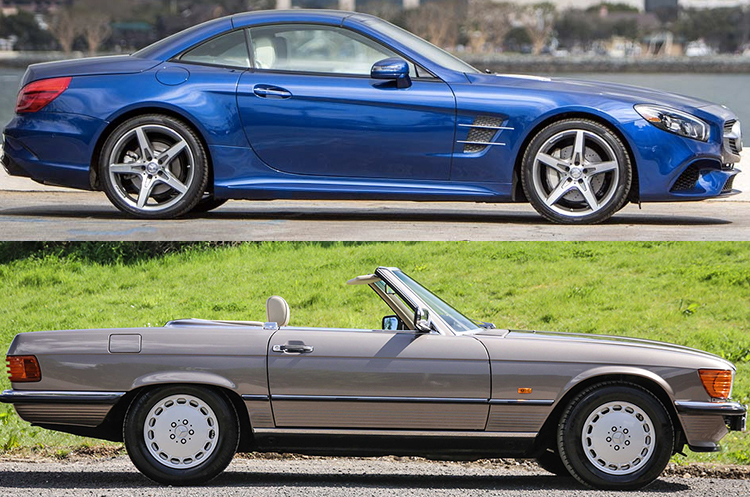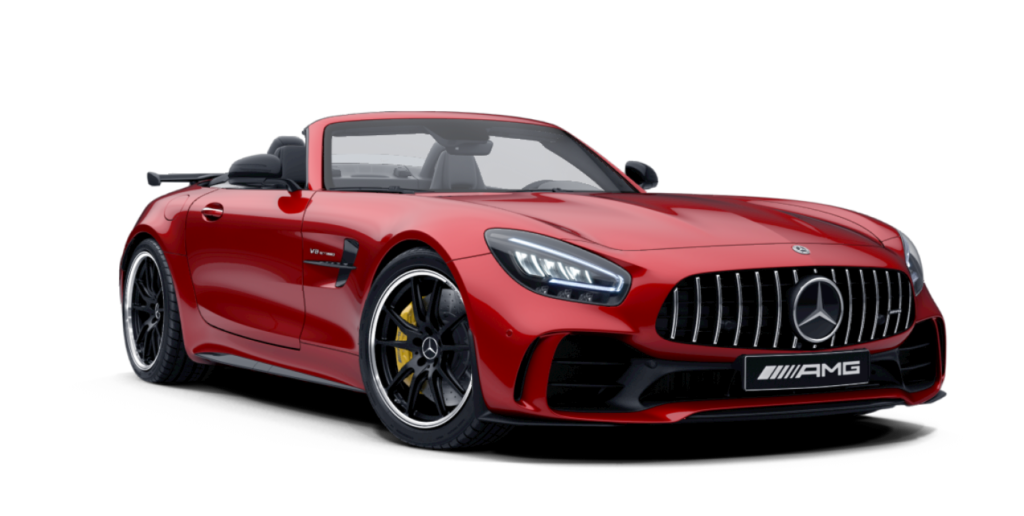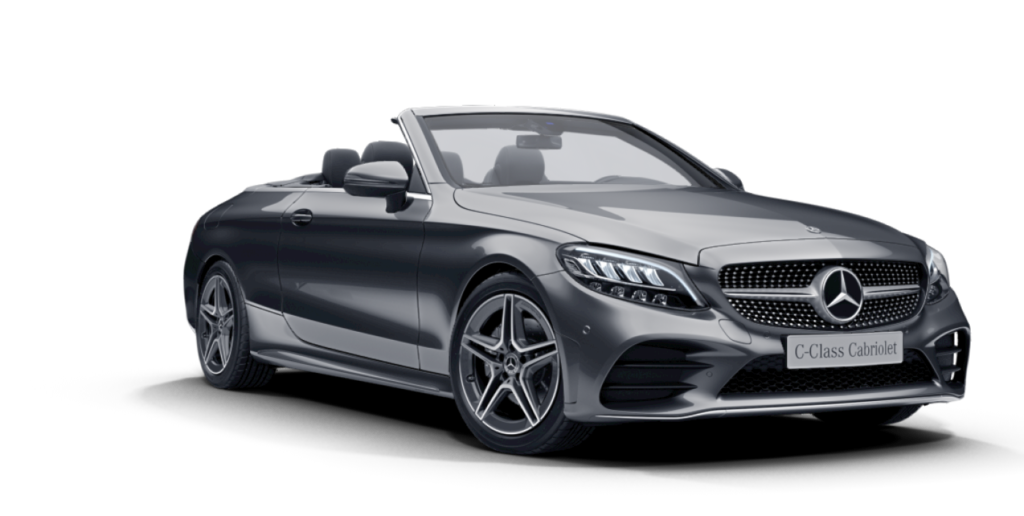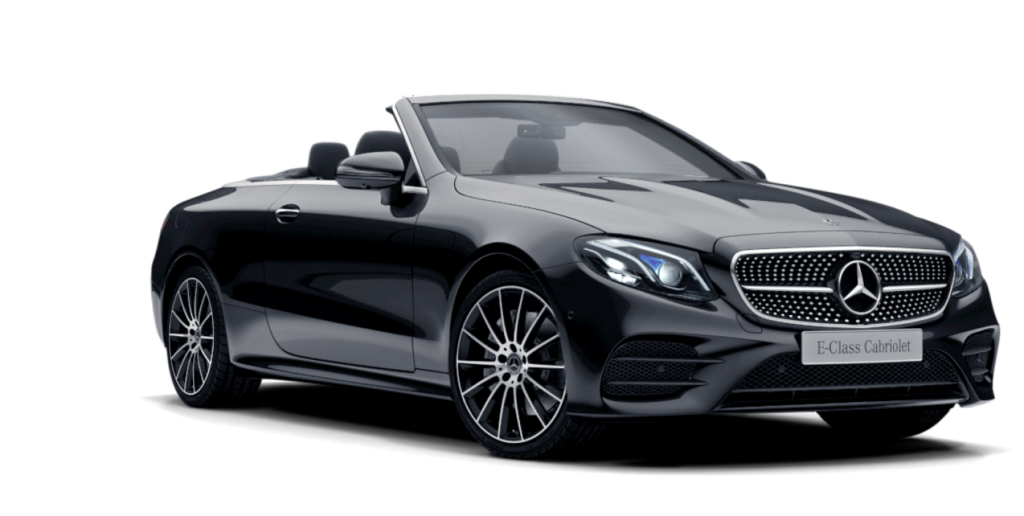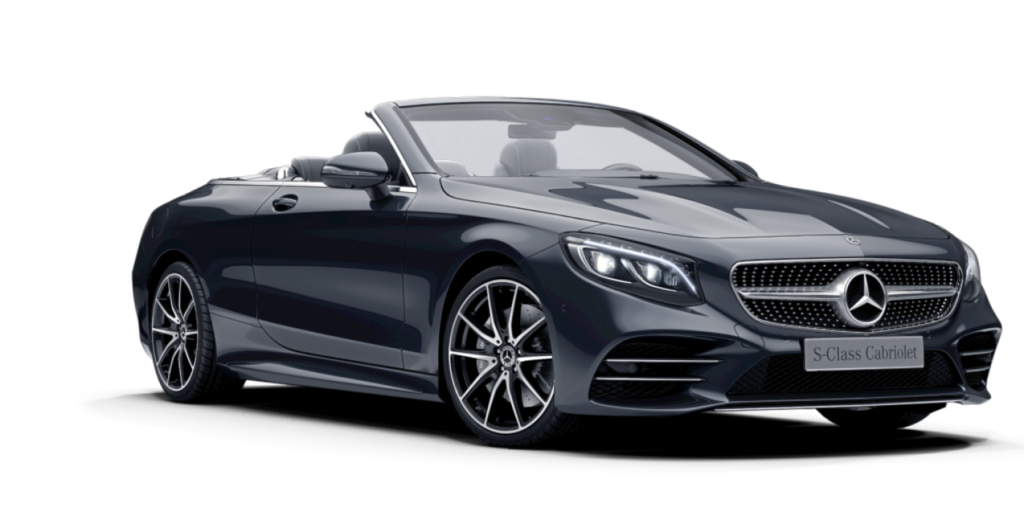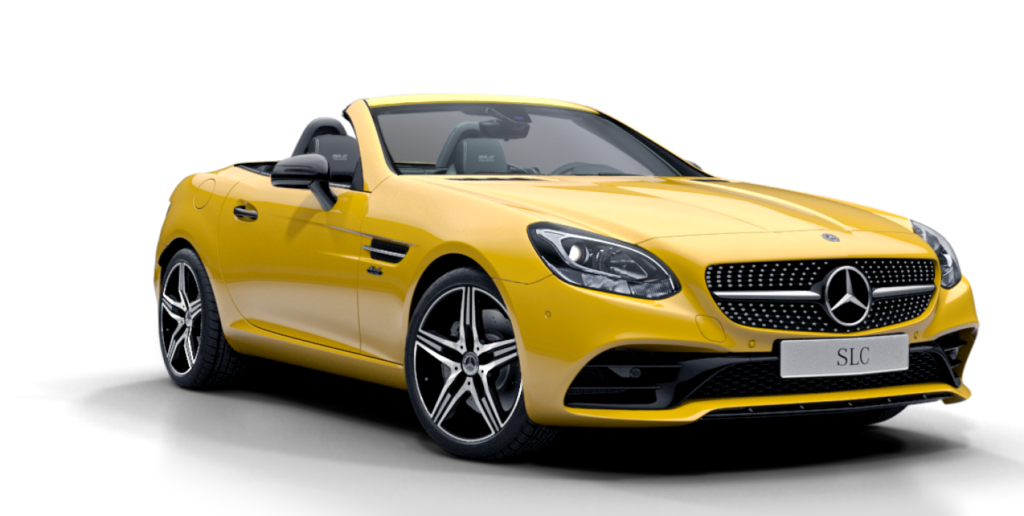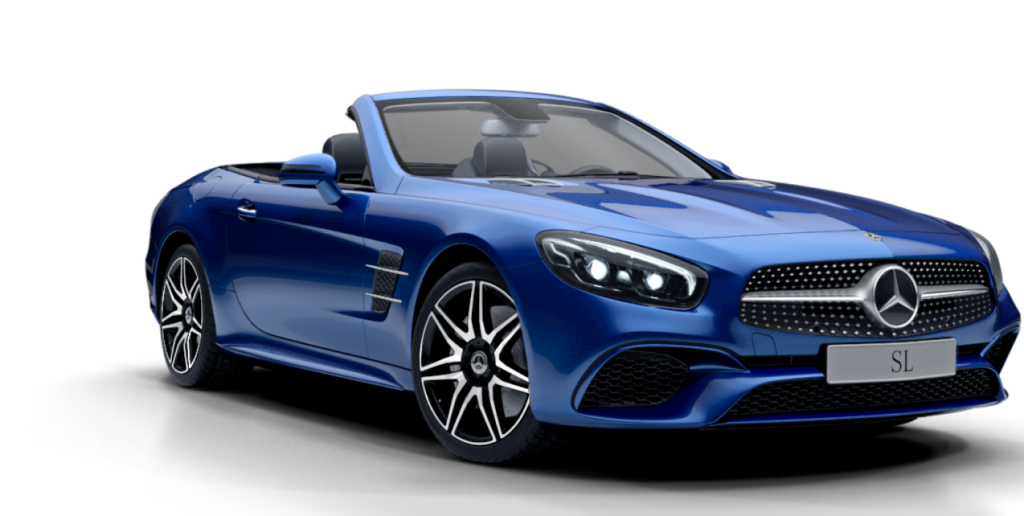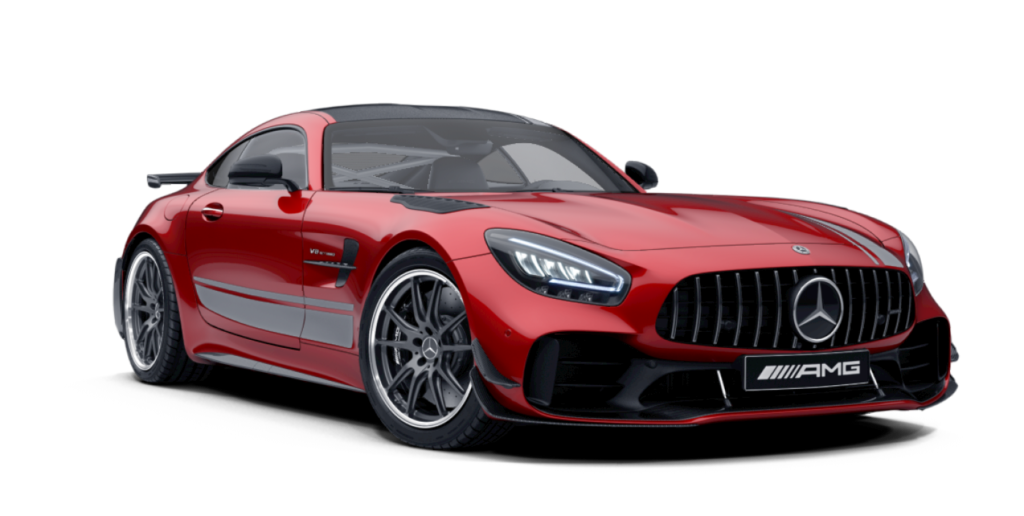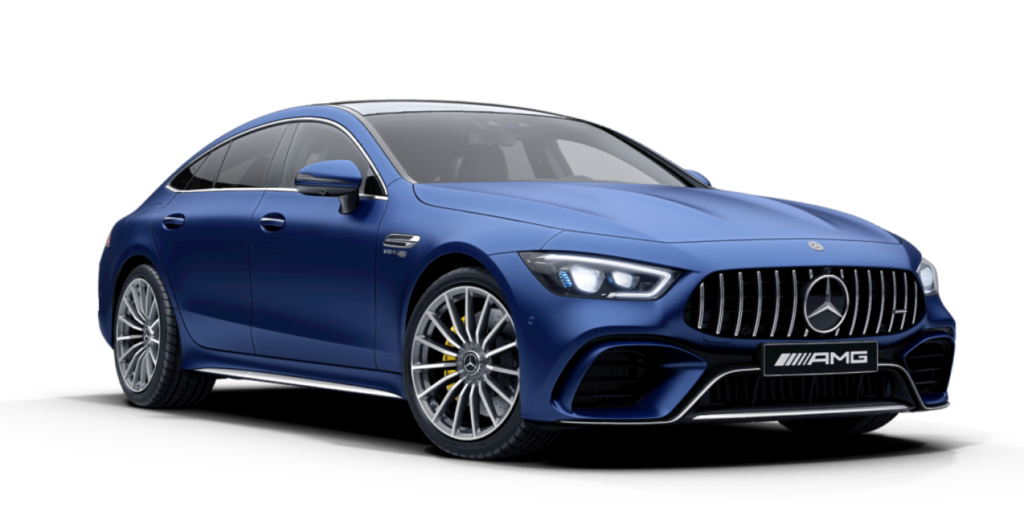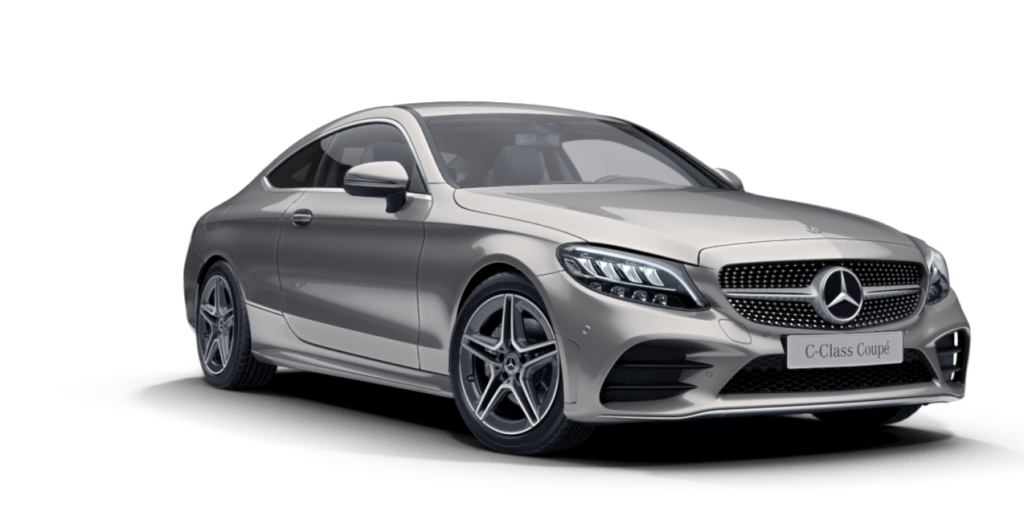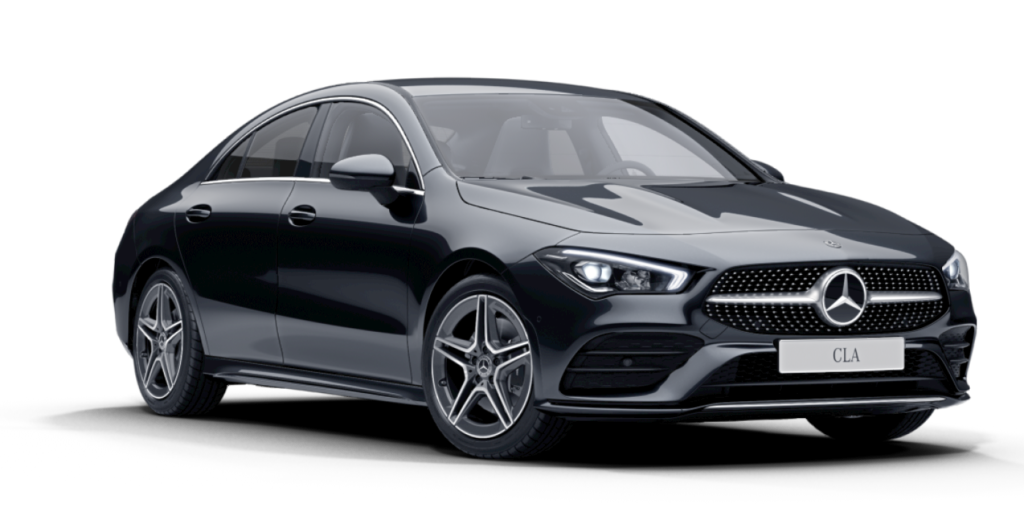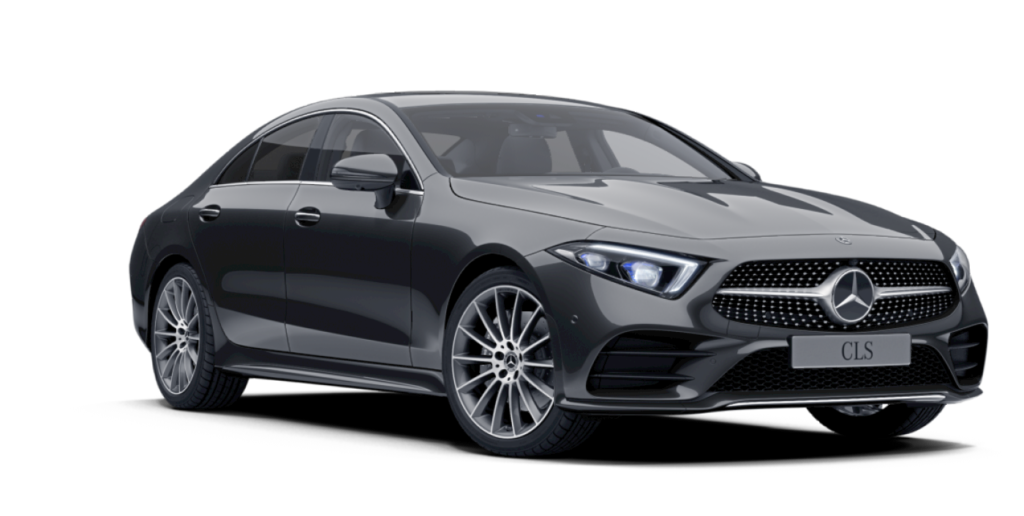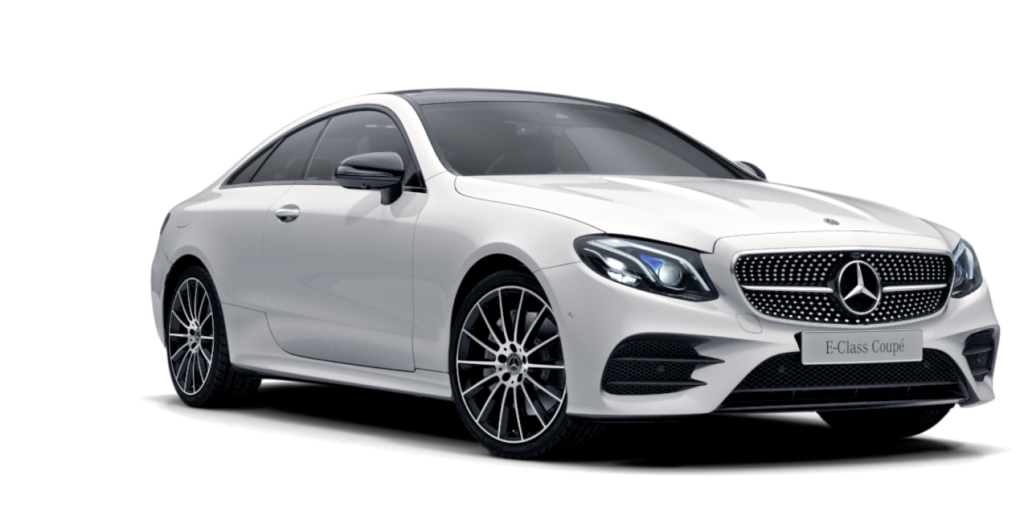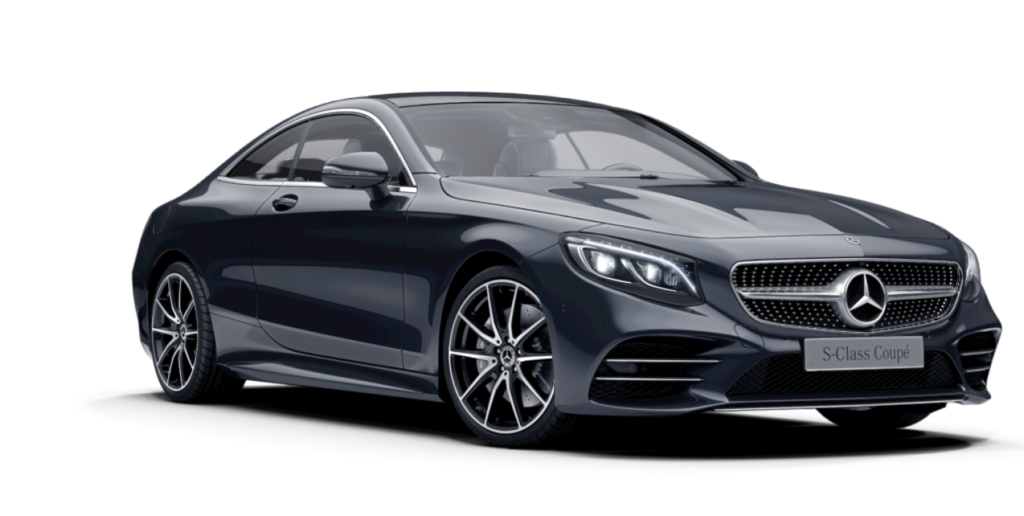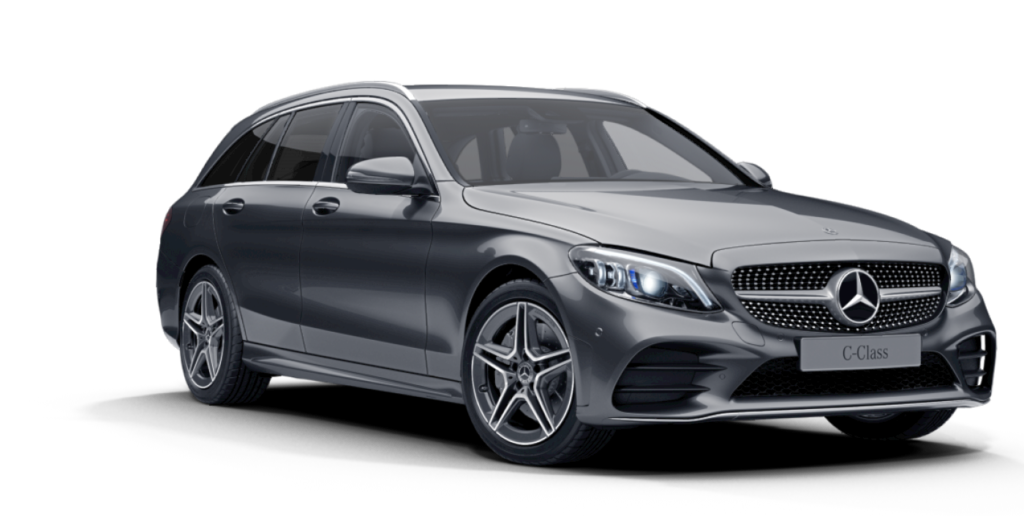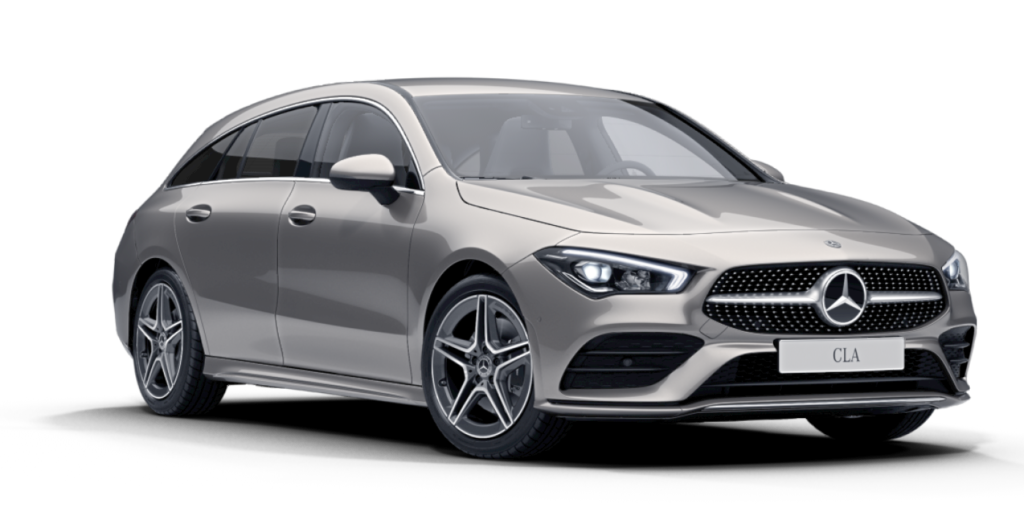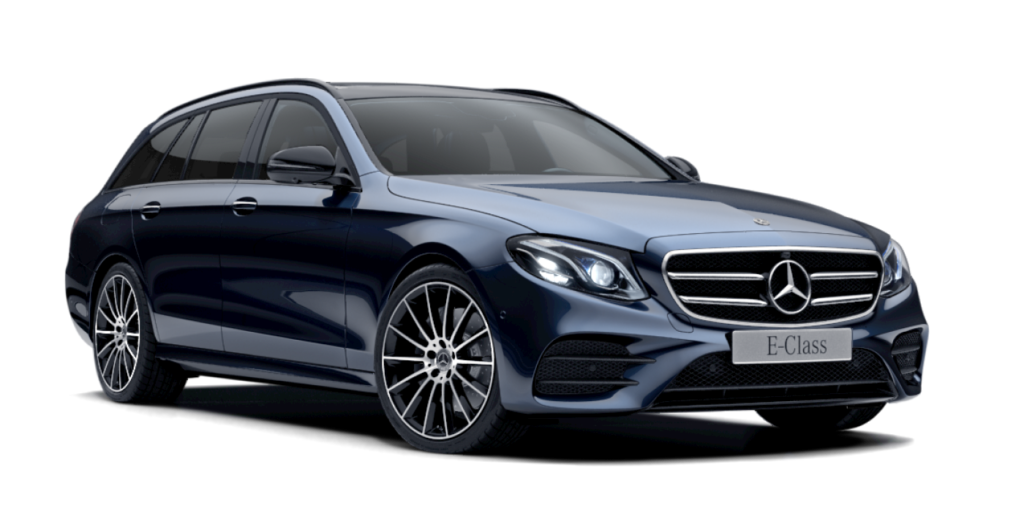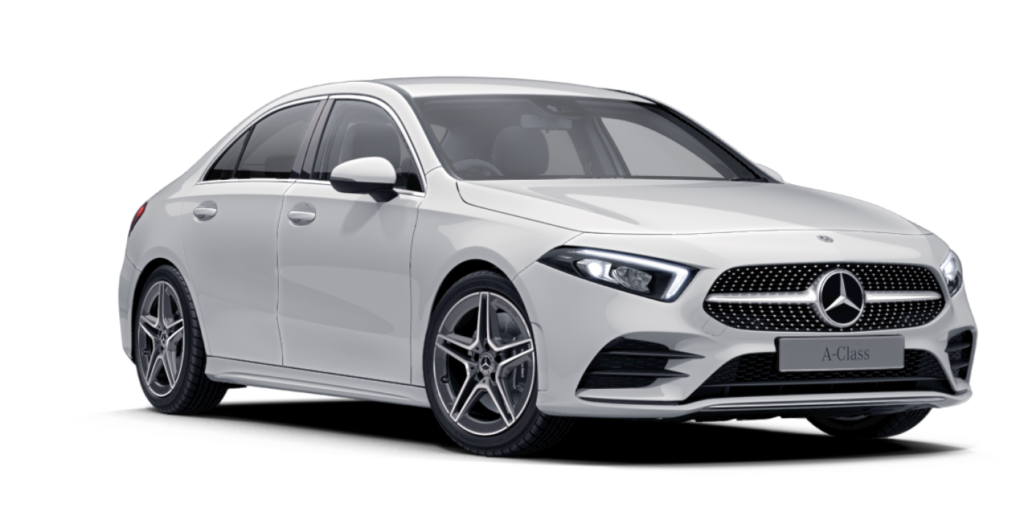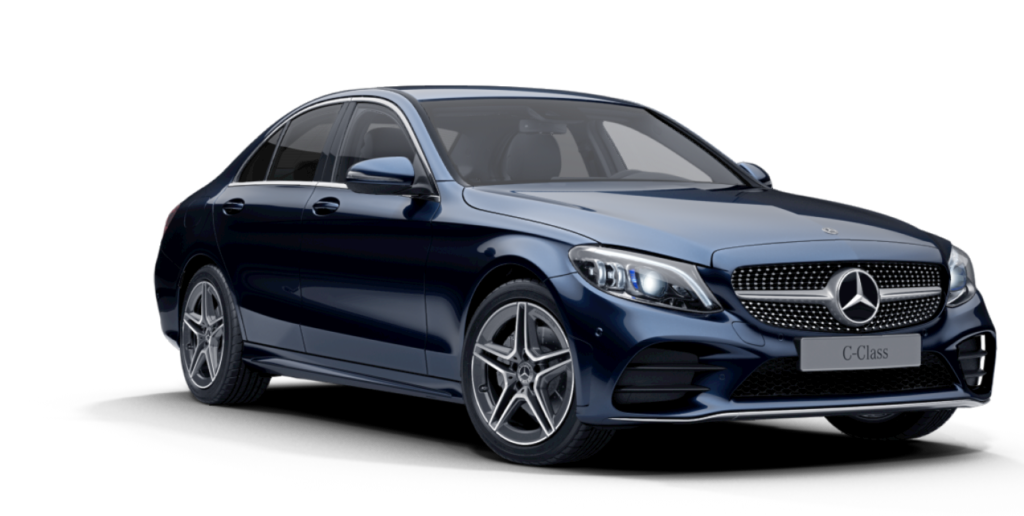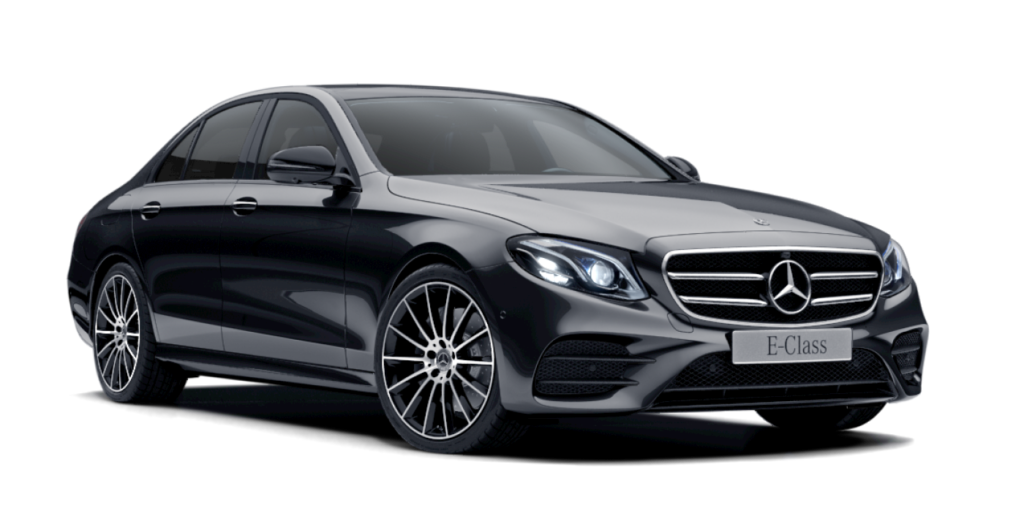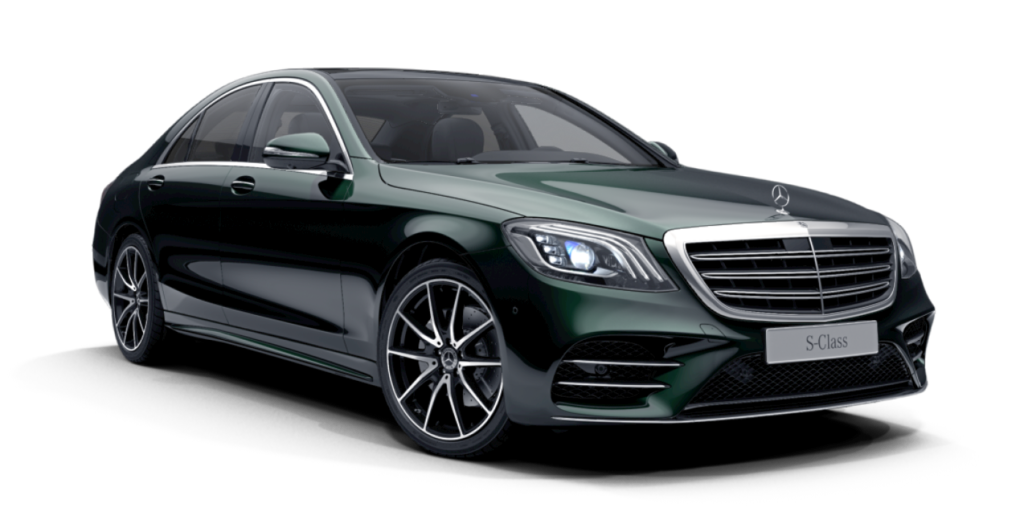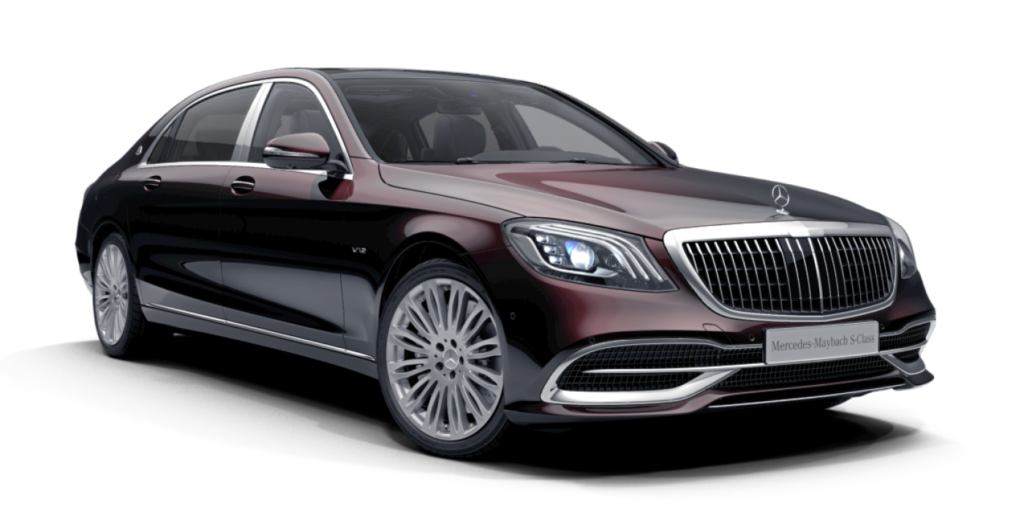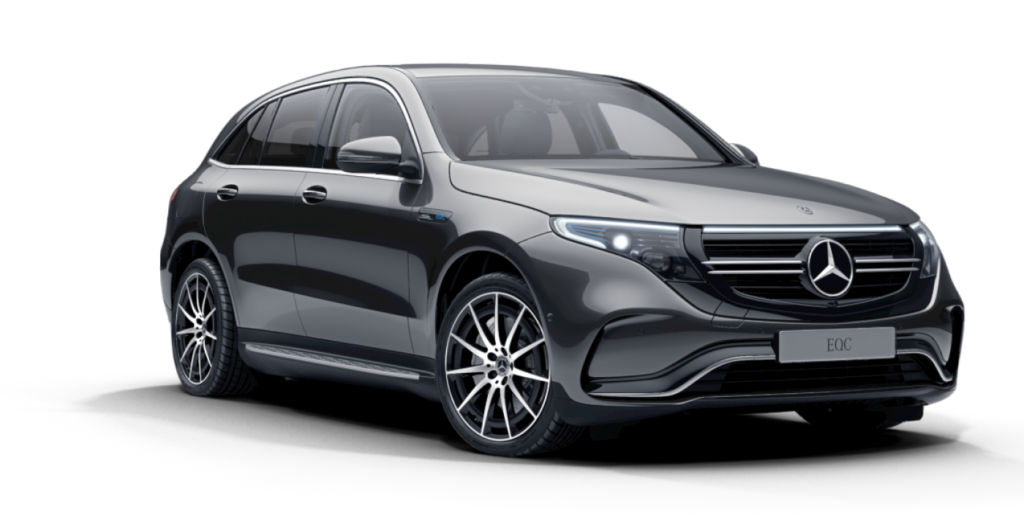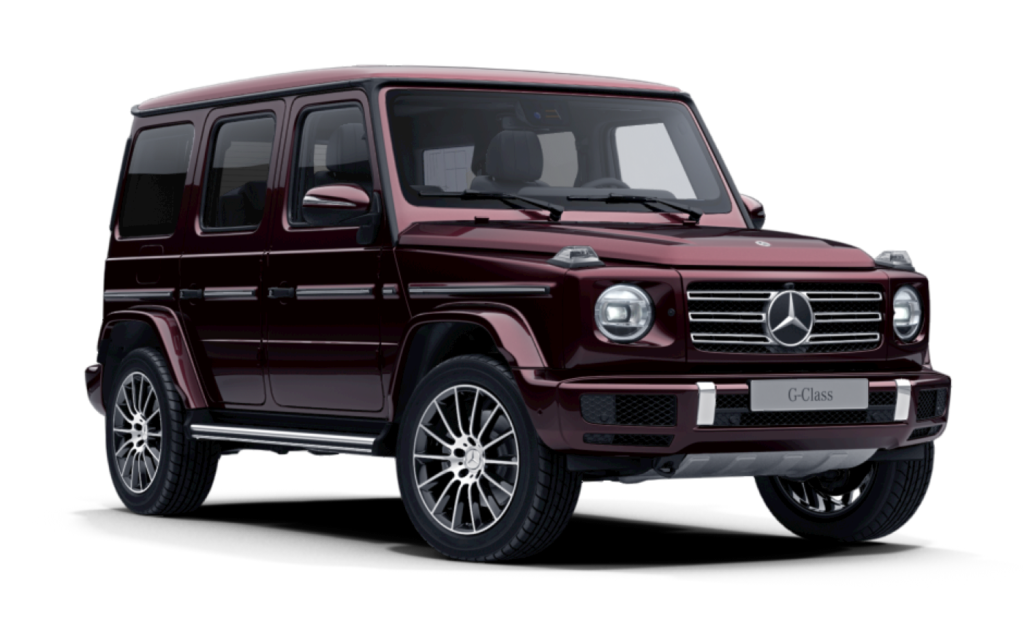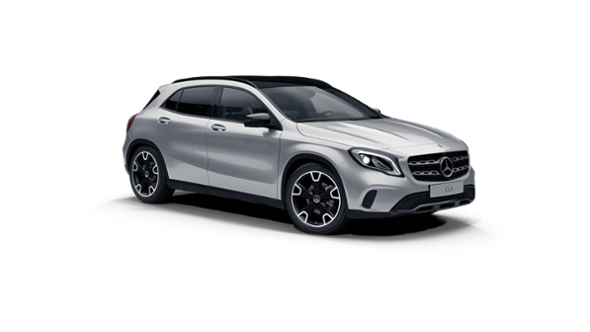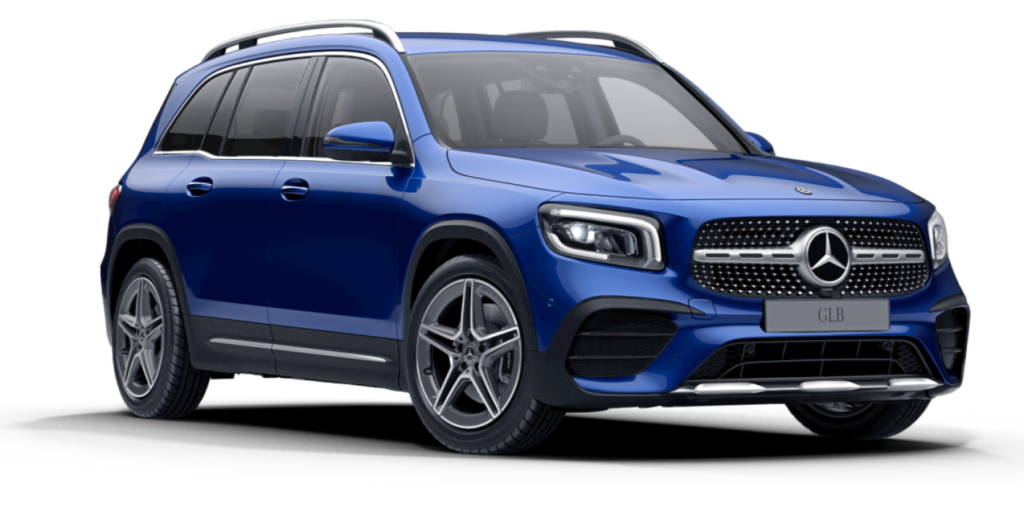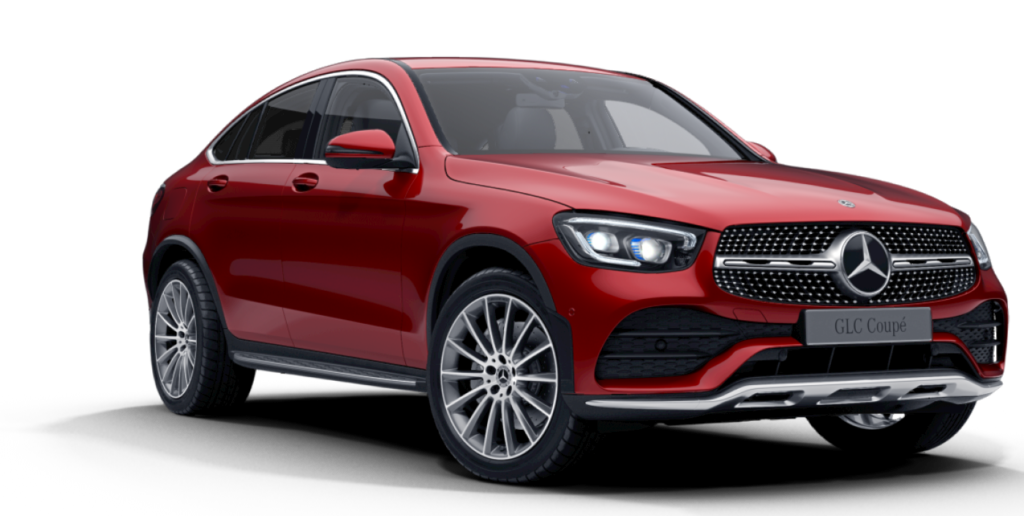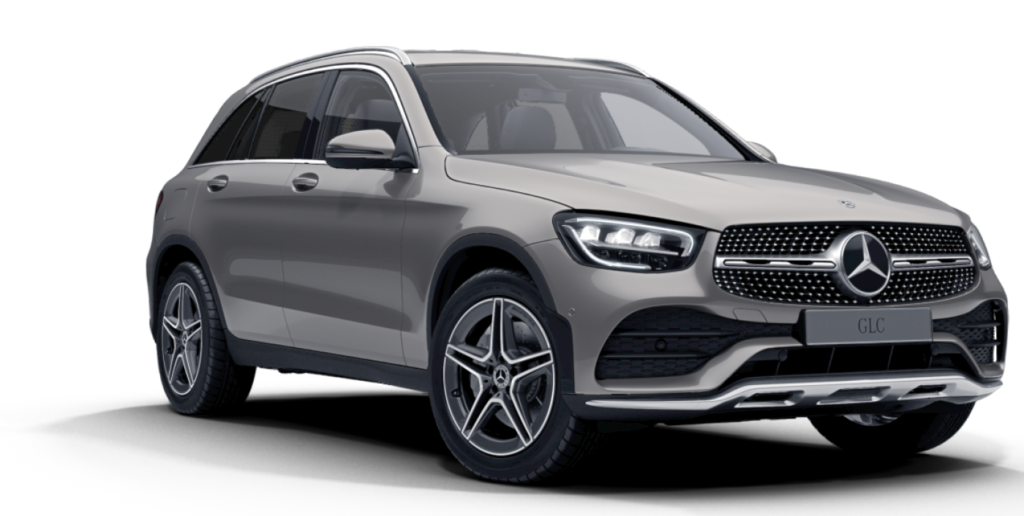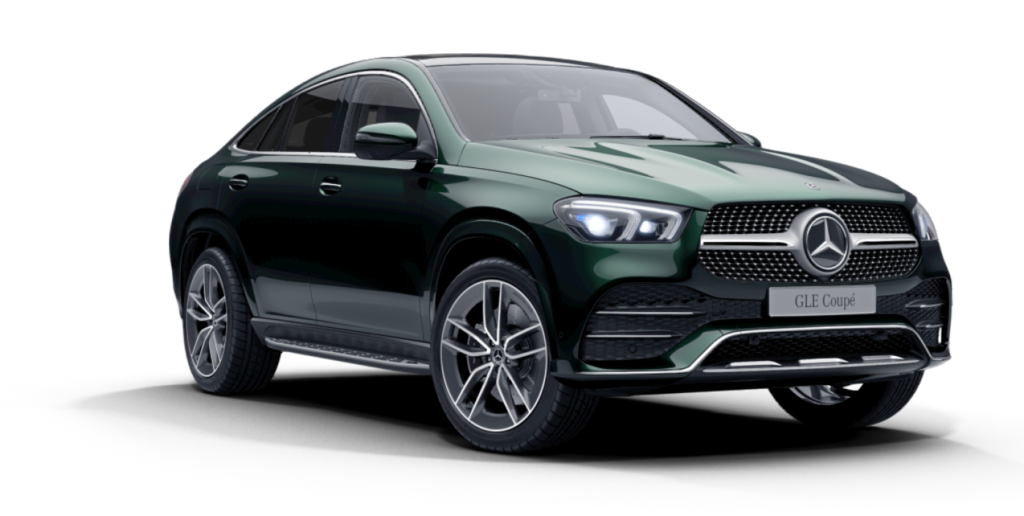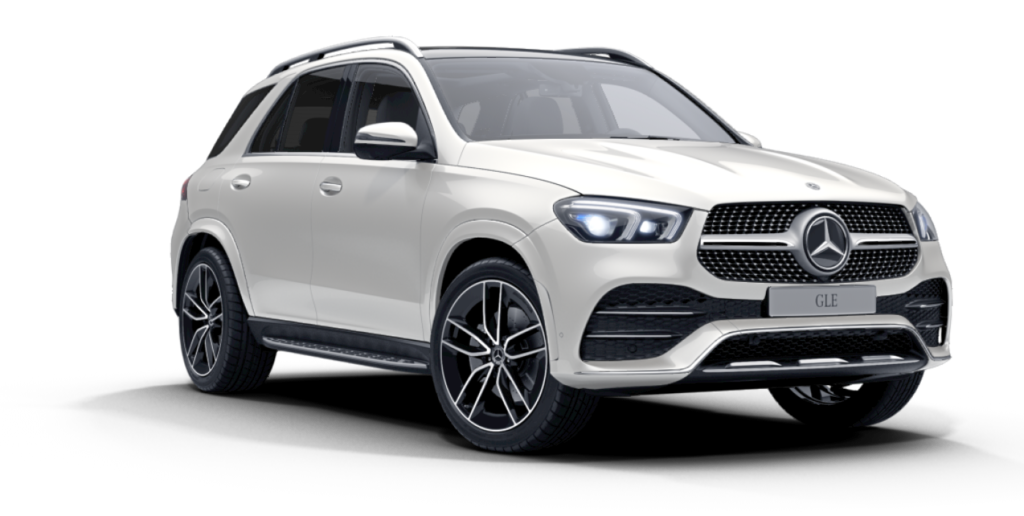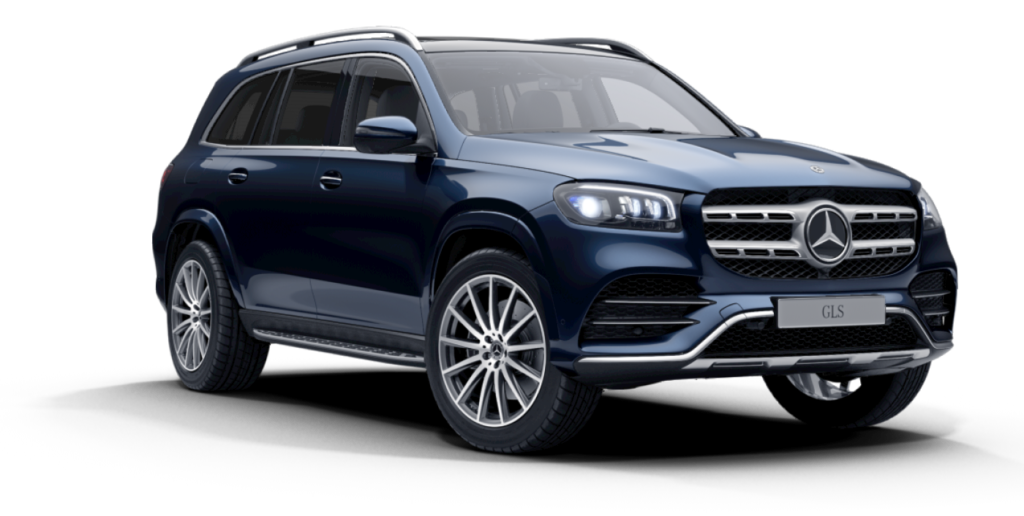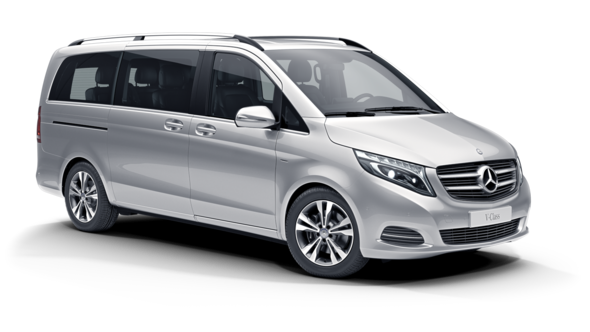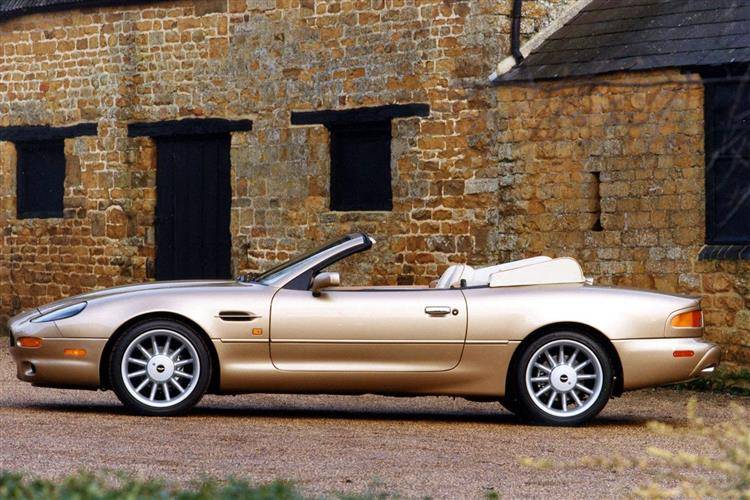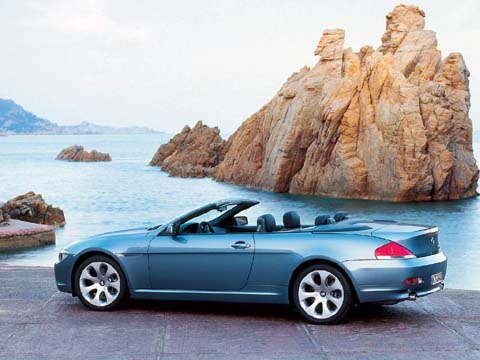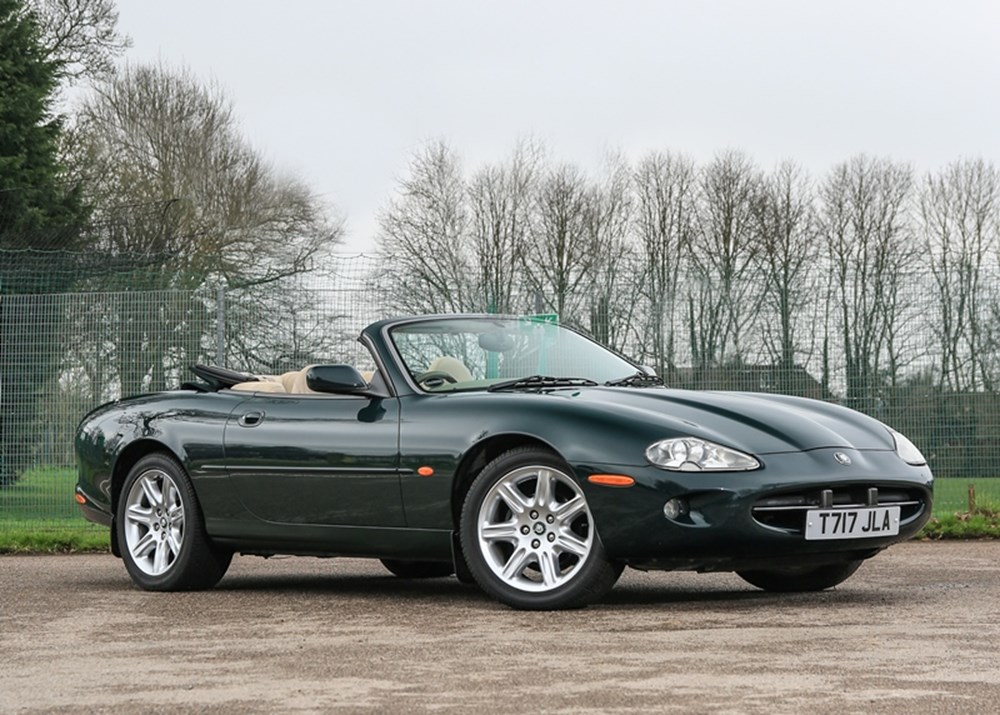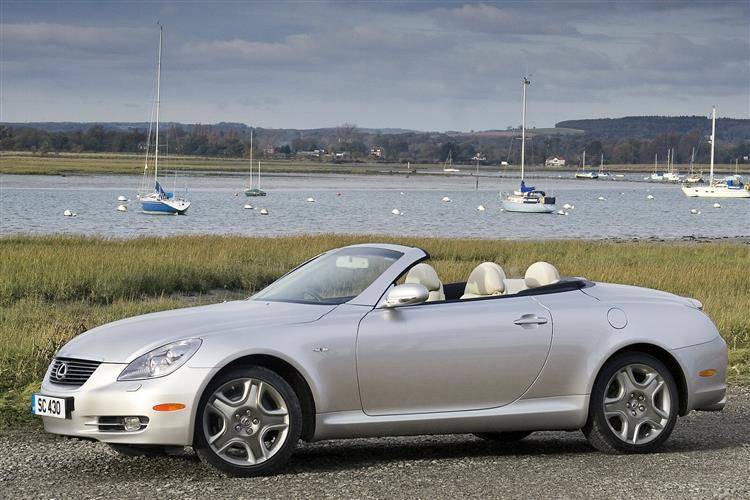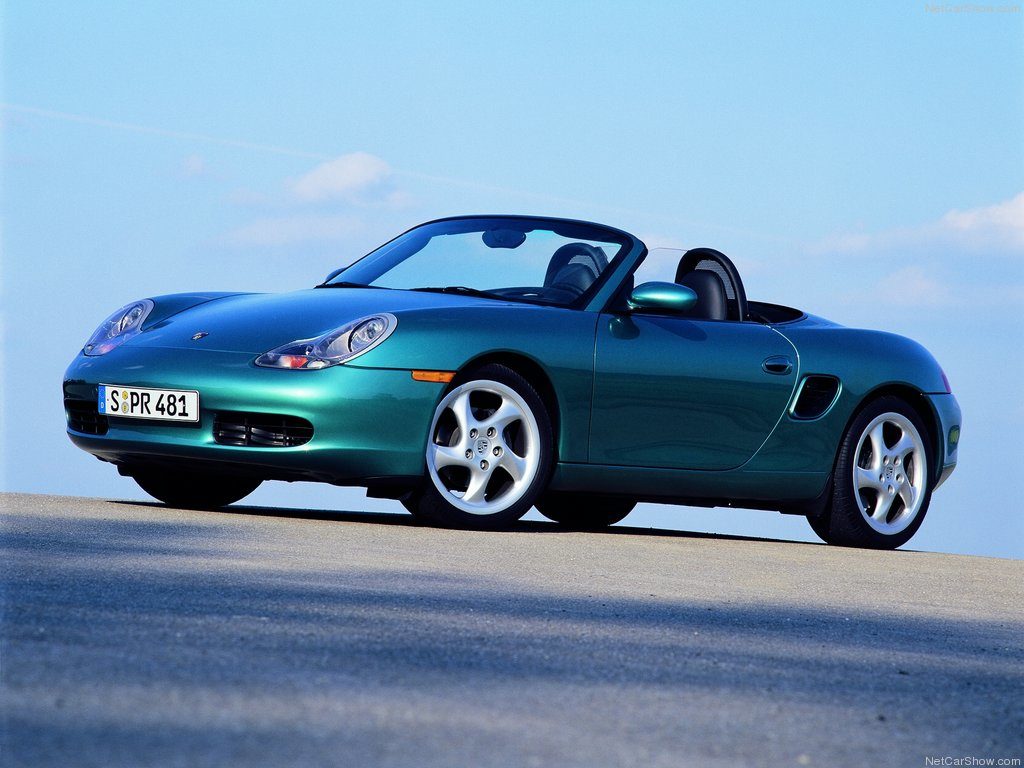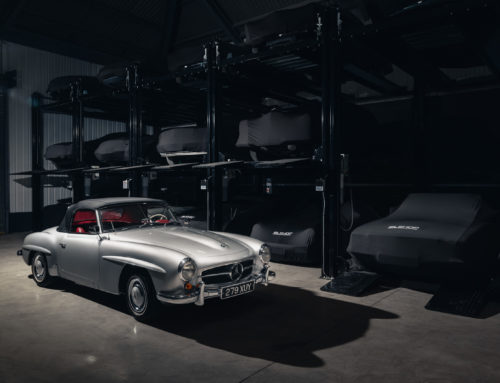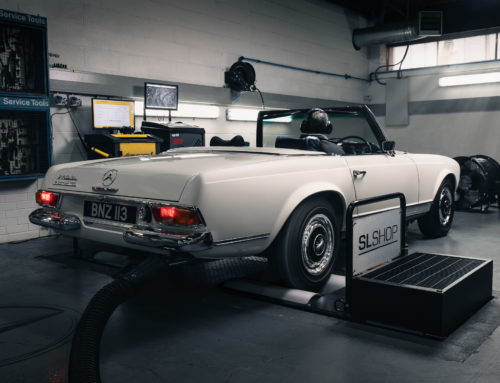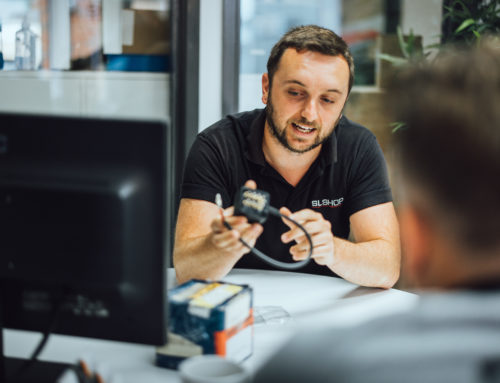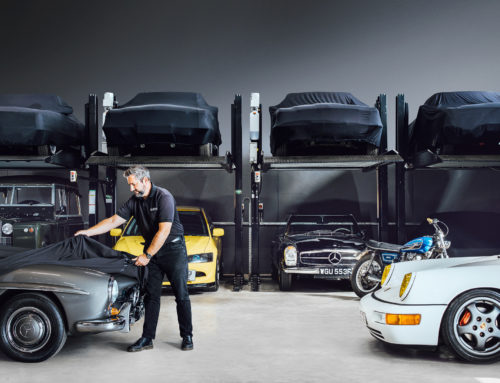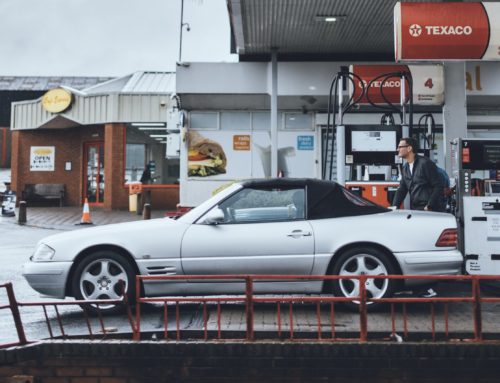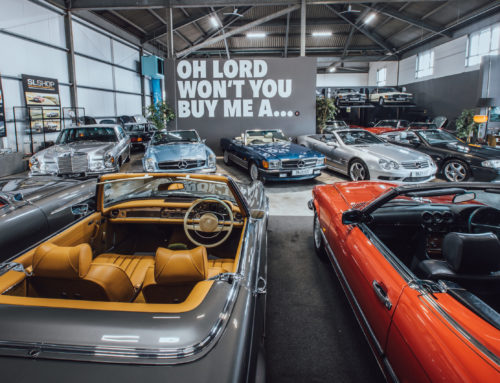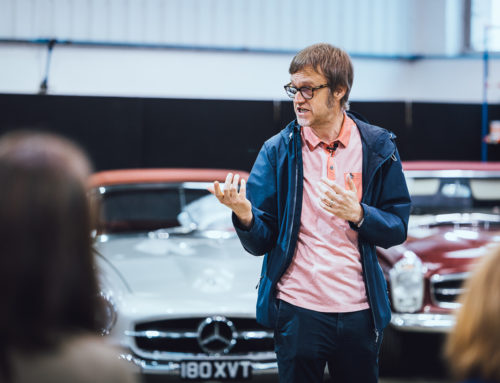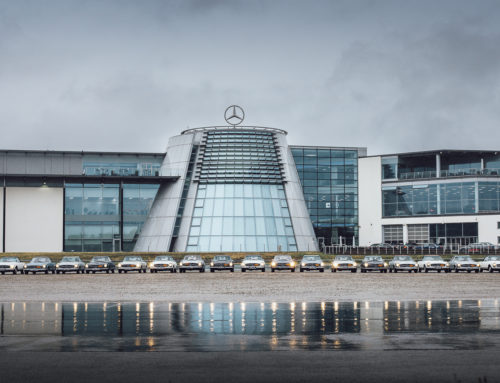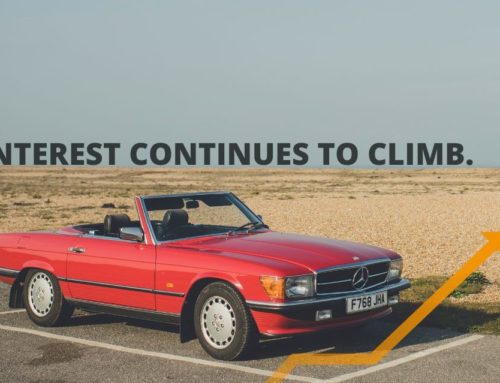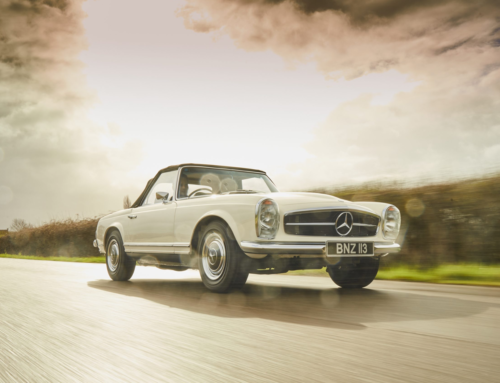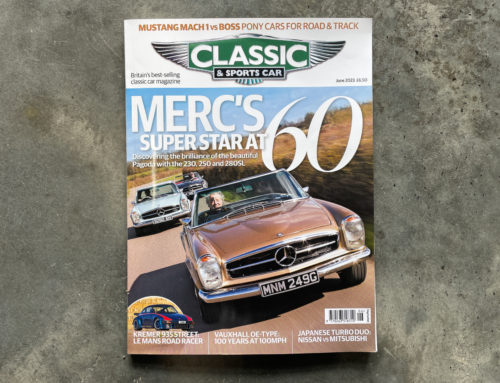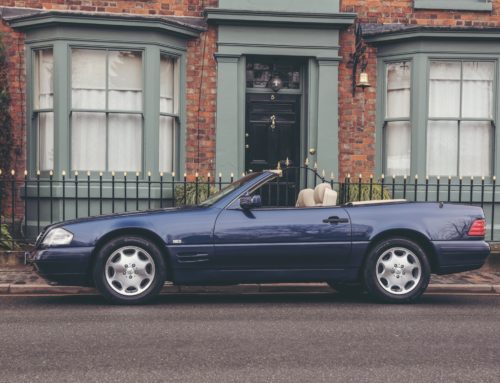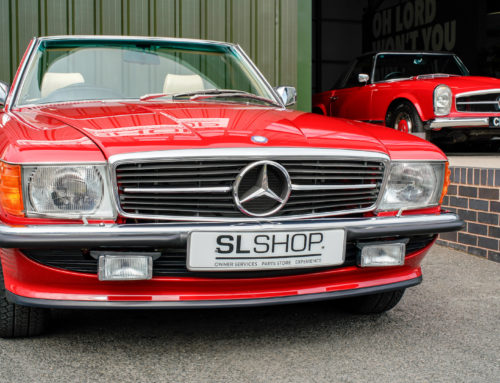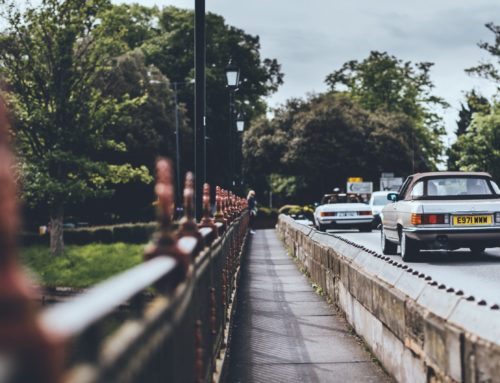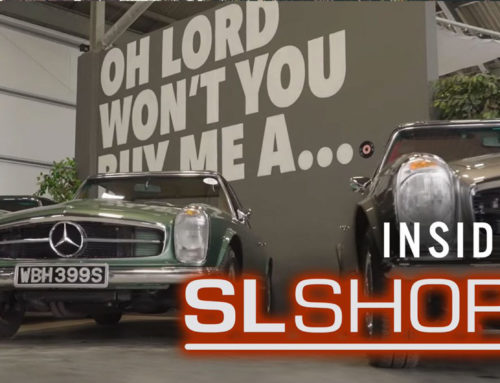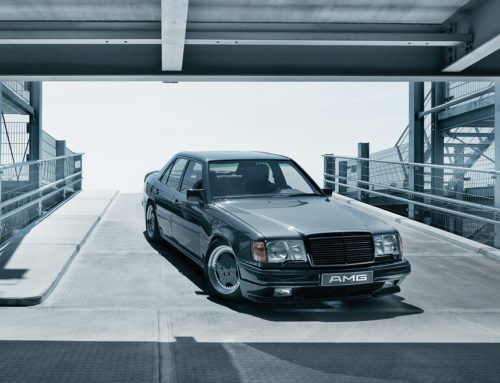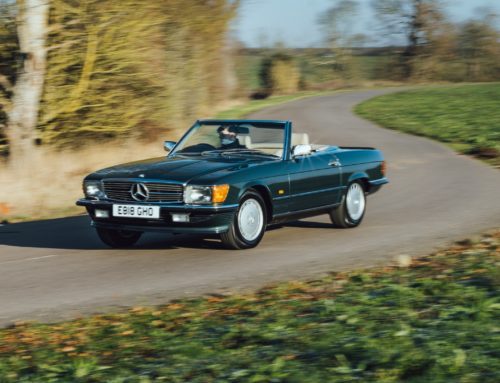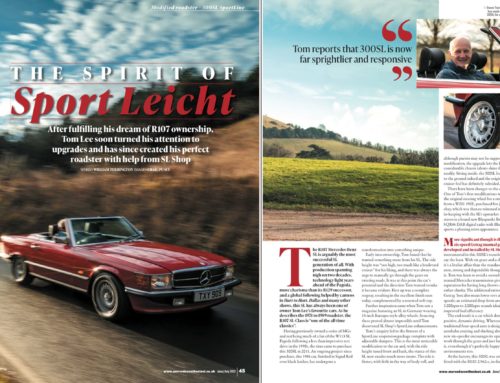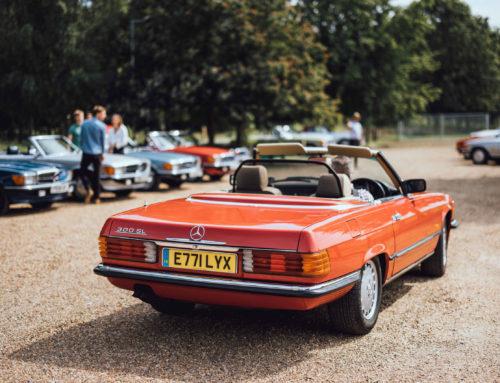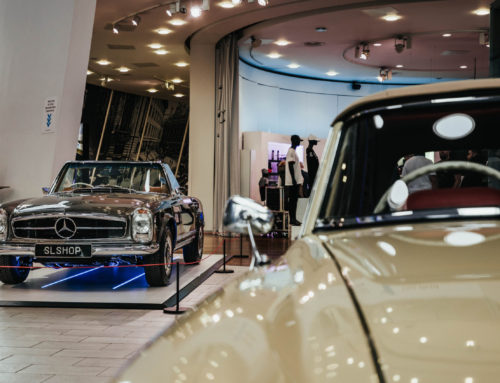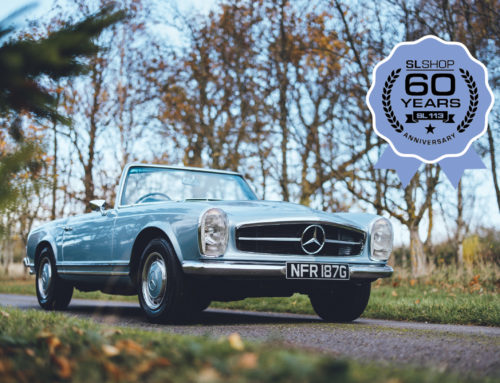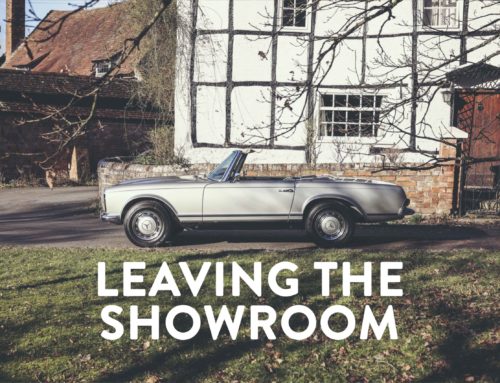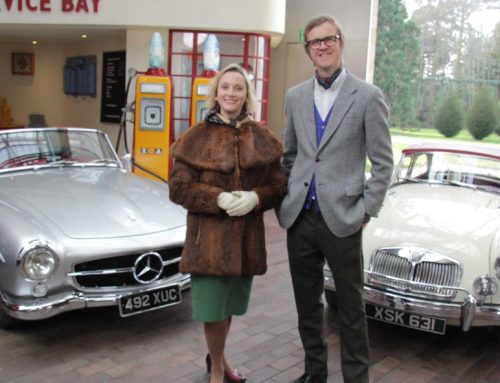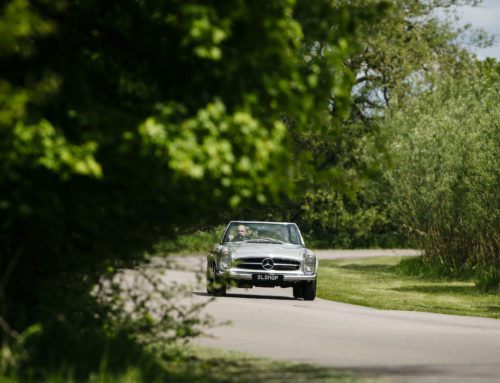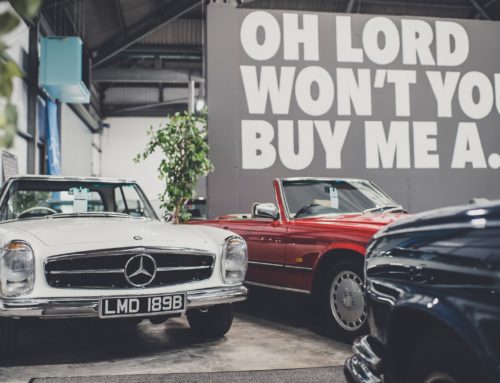When the Mercedes-Benz R107 SL first arrived in 1971 it was an instant hit, a car so good that it would remain desirable, popular and relevant for a full 18 years.
The fact that the Mercedes-Benz R107 SL lived through two vibrant decades at the top of the market is an incredible achievement; and one that would never be repeated. The automotive landscape has changed greatly since the R107… things have changed.
So why in 2020, 30 years and 4 SL generations later (R129, R230, R231, R232) is the R107 still as relevant and desirable as ever?

A question of choice – the automotive market has changed
Back in 1989 Mercedes-Benz buyers had a choice of the 190E (small saloon) the 124 (bigger saloon, coupe or estate) the W126 (even bigger saloon, long wheel base saloon or big coupe) G Wagon (off roader) and the SL (luxurious convertible).
That’s a choice of just 8 models.
Mercedes-Benz Model Range 1989:
-
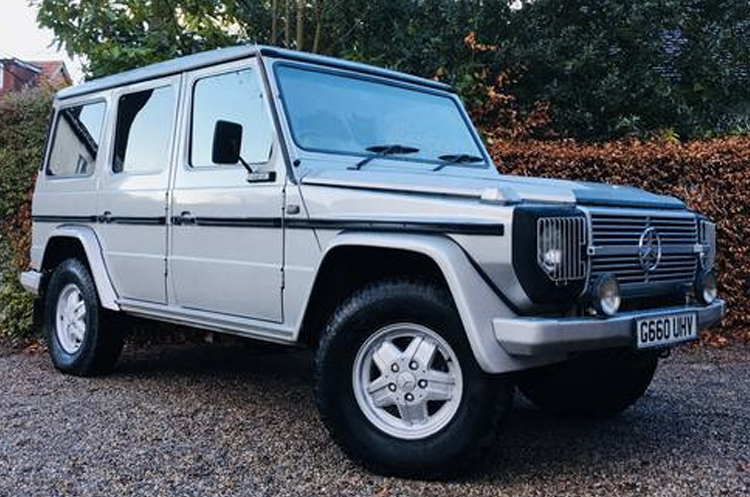
G Class -
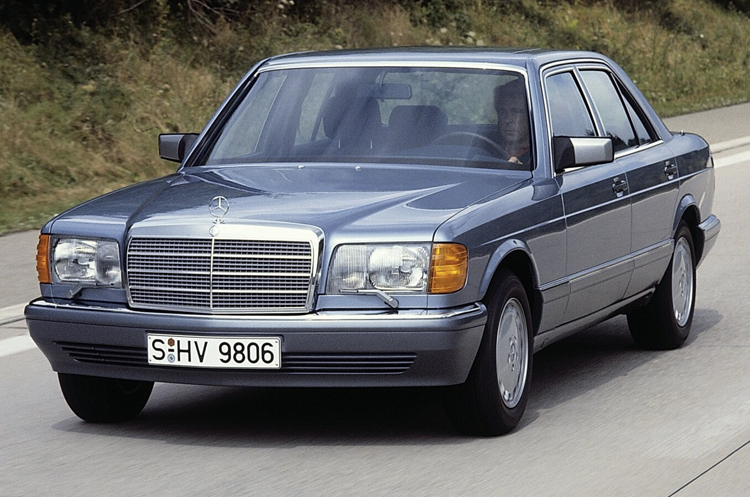
W126 Saloon -
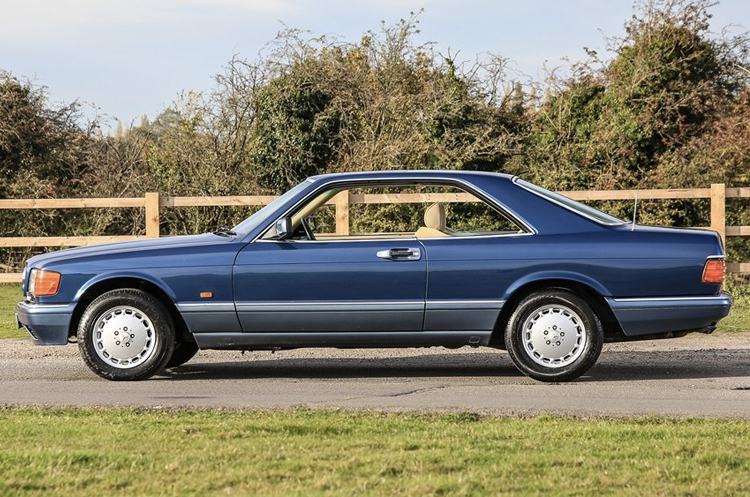
W126 Coupe -
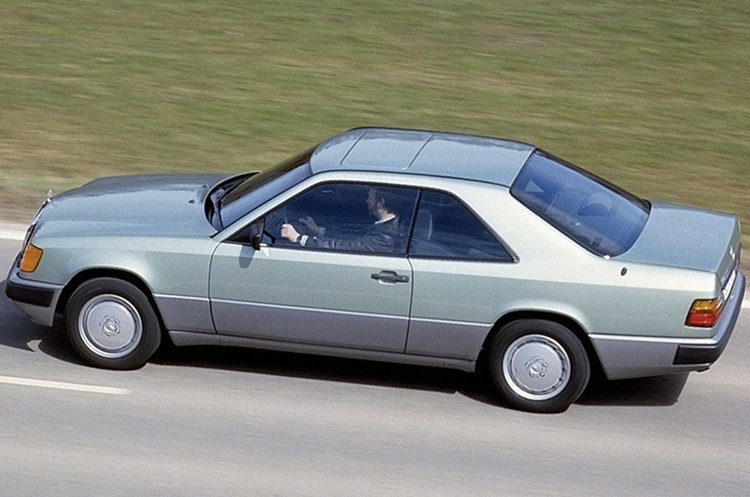
W124 Coupe -
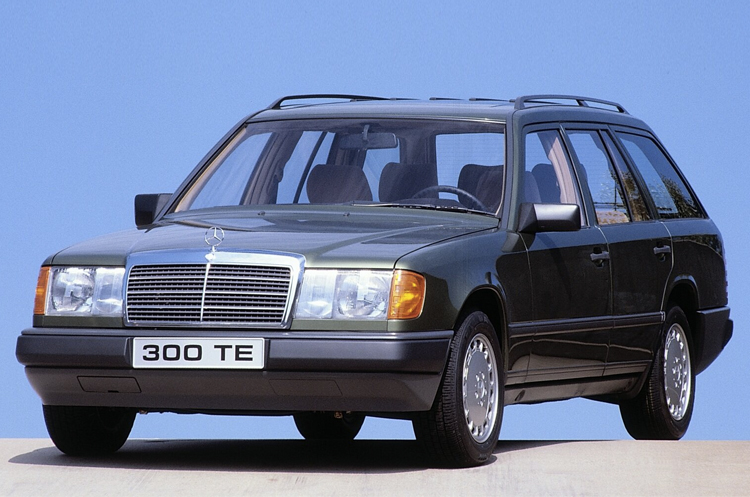
W124 Estate -
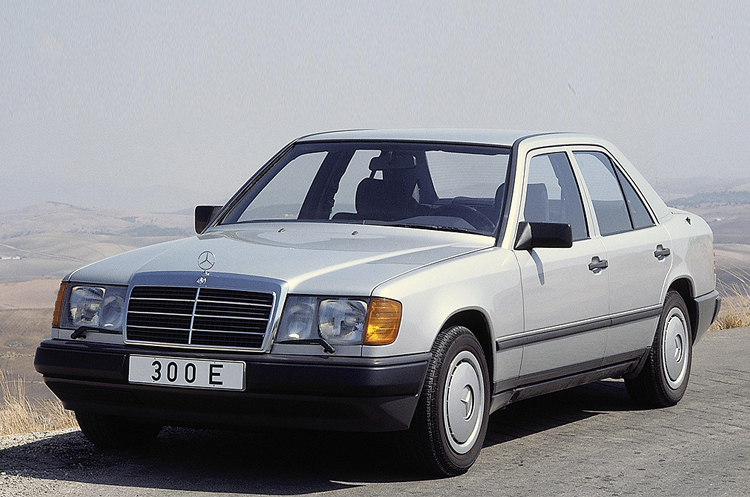
W124 Saloon -
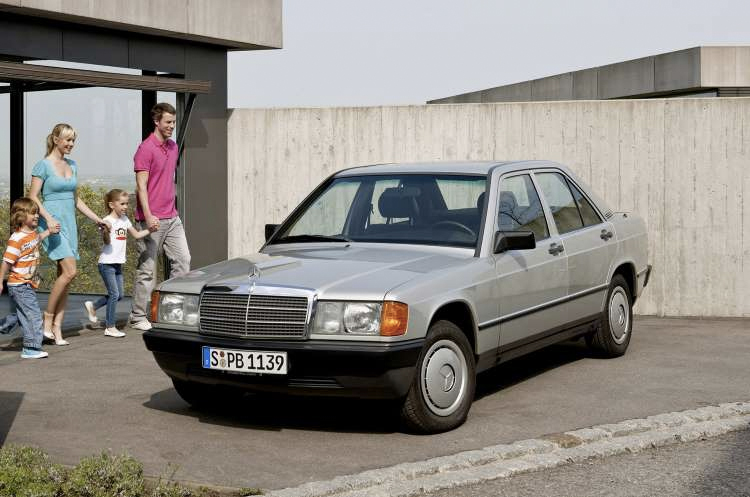
W201 190E -
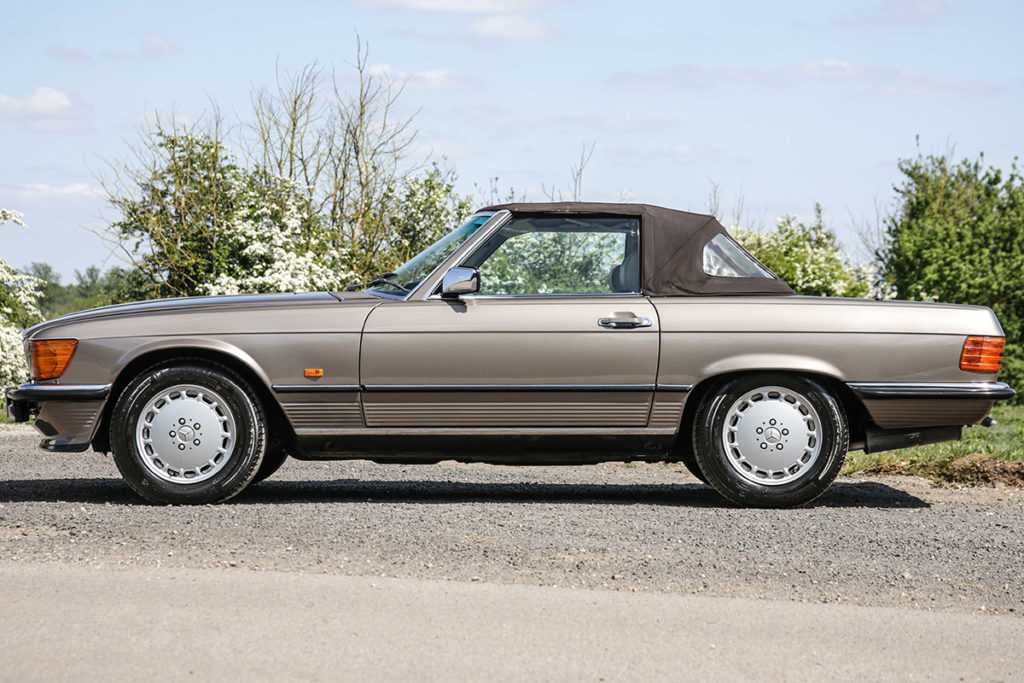
R107 SL
Fast forward 30 years and the automotive landscape is much more complex. In 2020 Mercedes-Benz buyers can have…
A hatchback (A Class), a bigger hatchback (B Class), a very small saloon (CLA), a small saloon (C Class), a bigger saloon (E Class), an even bigger saloon (S Class) a gigantic saloon (Maybach), a small estate (CLA), a medium estate (C Class), and a bigger estate (E Class)
Then it gets confusing…
A chunky looking hatchback off roader, (GLA), a small off roader that looks big (GLB), a small off roader (GLC), a more coupe looking small off roader (GLC Coupe), an electric off roader (EQC), a bigger off roader (GLE), a bigger but more coupe looking off roader (GLE Coupe), a full size off roader (GLS) or a utilitarian off roader (G Class).
None of which apart from the G Class are meant to go off road.
That’s before we look at the coupes and convertibles…
You can have a small coupe (CLA), medium sized coupe (C Class), bigger coupe (E Class) or an even bigger coupe (S Class), a four dour coupe (CLS), a very fast coupe (AMG GT) or a very fast four dour coupe (AMG GT-4).
The convertible range is thankfully a little easier to understand…
You can have a medium sized convertible with four seats (C Class), a bigger convertible with four seats (E Class), an even bigger convertible with four seats (S Class)… or a small convertible with two seats (SLC or what used to be the SLK), a bigger convertible with two seats (SL) or a very fast one with two seats (AMG GT).
Within all of those ranges you can have a cheap one that looks expensive, an economical one that looks fast, a slow one that looks fast, and a fast one that looks like a fast one. Or any combination of the above. Or a van. With or without seats and windows. Clear?
That’s a choice of more than 30 models!
Mercedes-Benz Model Range 2020:
Confused yet? You haven’t even started looking at the options list for interior equipment!
Back in 1989 prospective R107 SL buyers had a choice of 3 engines, with 14 different optional extras to choose from, as seen in our blog here.
In 2020 prospective SL buyers can choose from two trim levels, two engines, a multitude of equipment packs and a confusing plethora of optional extras.
A 2020 SL is available with 2 engines, 8 exterior or 3 interior colours.
A 1989 R107 SL was available with 3 engines, 10 flat colours, 14 metallic colours, and 8 variants of MB TEX, 8 variants of cloth and 8 variants of leather!
We might have laboured the point a little; but in 2020 we have more choice but it’s all at the expense of actually having choice. The modern options list gives plenty of choice over what your car can do, but less choice over what it looks like and how it feels.
When we advertise an R107 SL for sale and we say it’s a rare colour combination, we genuinely mean it. When we advertise an SL for sale and we say it’s a high specification car with many expensive options, we genuinely mean it.
The SL comes from a time in automotive history that was completely different to the world of motoring today.
There are certain colour and trim combinations for the R107 that we have never seen here at SLSHOP, despite the thousands of cars that have attended our workshops and showroom over the years. For us as enthusiasts and connoisseurs, that makes these rare old cars all the more appealing. The more unusual the colour and specification, the more special a car becomes. The cars shown below are good examples of this. Mid red leather is very rare to find, and we’ve only seen one Pine Green car to date.
(both of these cars can be found for sale in our showroom).
-
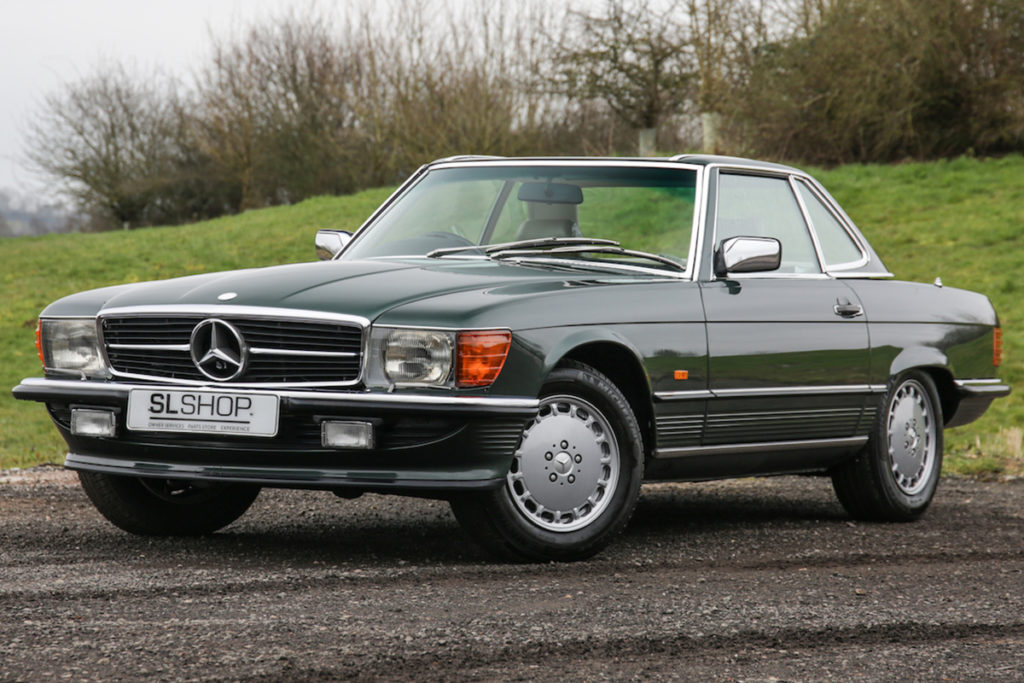
Pine Green… -
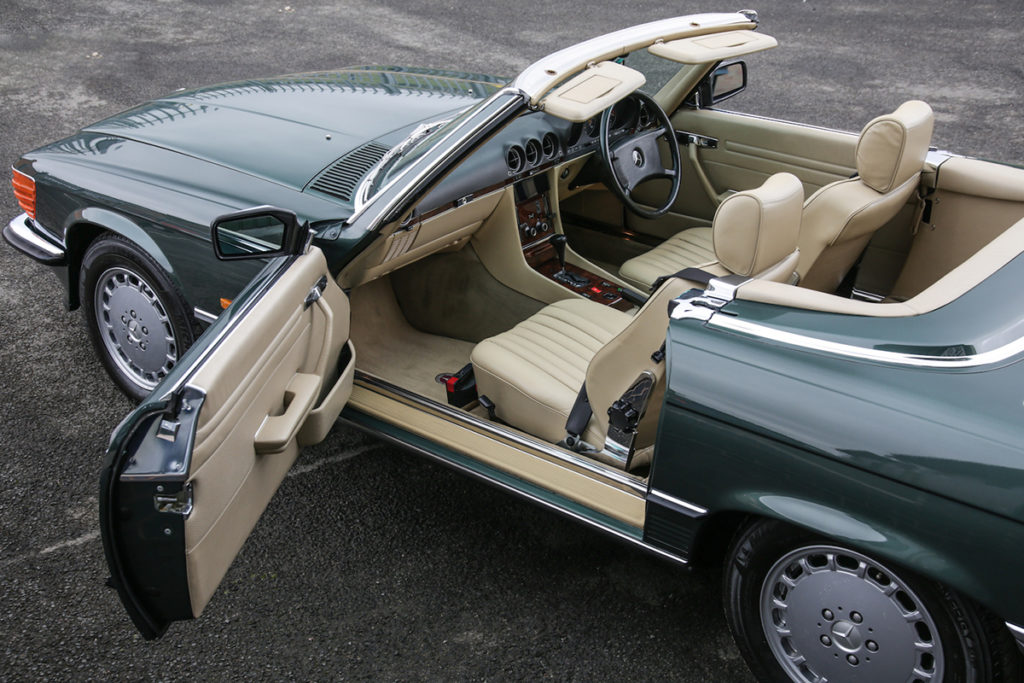
with Mushroom Leather -
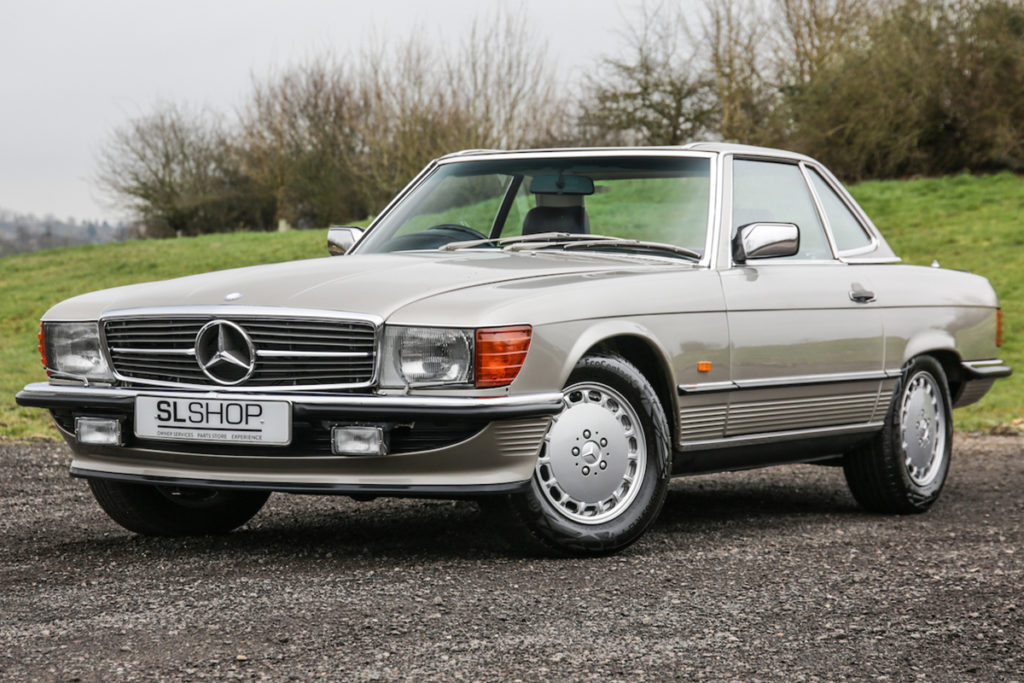
Astral Silver… -
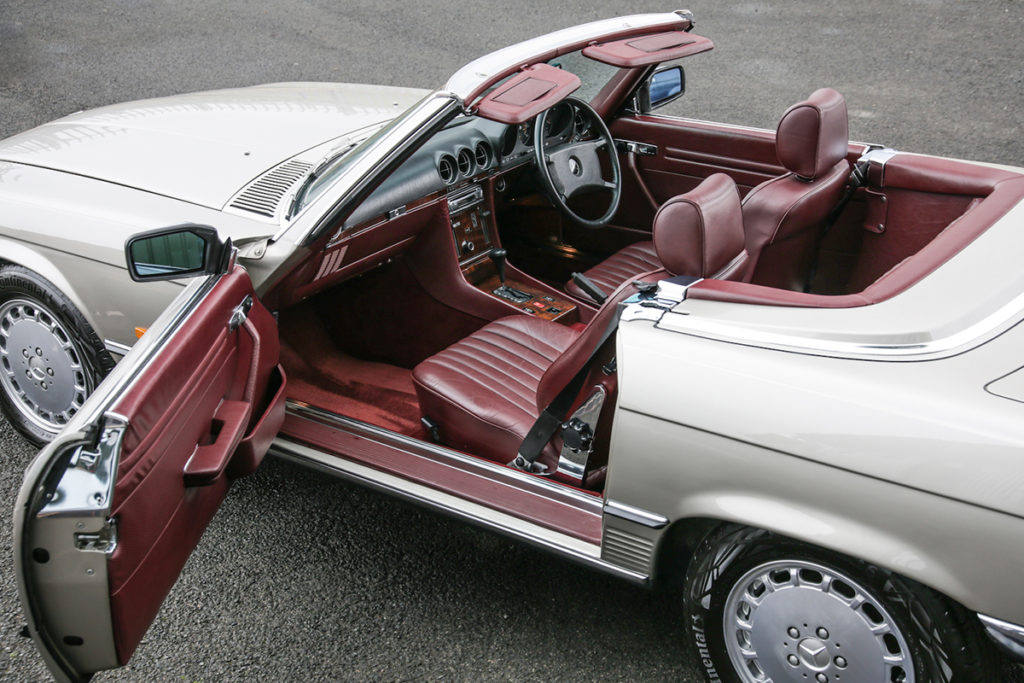
with Mid Red Leather
The Competition is finally competing
In a previous blog we’ve talked about the SL as a car without equal, a car that spent two decades without an obvious natural competitor. The R107 enjoyed a largely unchallenged reign in the luxury convertible sector – it was never intended to be a true sports car and it never pretended to be a true four-seater. As the SL developed and the R129 came to the fore, the competition from other manufacturers also increased. The R129 was facing a perfect storm of changing tastes and increased competition.
Jaguar’s XK8 arrived in the mid 1990s, BMW whipped the roof off the 6 Series in 2004 and contenders arrived from the likes of Lexus. In 1991 Ford took over Aston Martin, another company looking to steal market share from the all-conquering SL.
Not only was the SL facing competition from other luxury marques, but also the arrival of the Mazda MX5 changed the way we see open top cars forever. The decline of the British sports car played directly into the hands of the Mazda MX5, which arrived in 1989. The small sports car market was revived, a market that had floundered as the British motor industry declined. The success of the MX5 was followed by the MG F, BMW Z3 and then Mercedes-Benz’ own SLK, creating another sub-market for potential SL buyers looking for open top thrills. These small convertibles were now taking large bites out of R129 market share, competition from an area of the market that had only ever nibbled the heels of the R107.
People don’t pay like they used to
It’s impossible to discuss the changing automotive landscape without mentioning the meteoric rise of car finance. In the olden days, an expensive car was the sign wealth. The company car system was totally different to how it is today. As people progressed financially they were able to advance up the automotive ladder of life. One might progress from an L to a GL, with the dream of one day owning a GLE… As was perfectly explained by James May et al when talking about the Ford Cortina range during an episode of the Grand Tour.
The point here is that in the 1970s and early 80s, the Mercedes-Benz SL was so fantastically expensive it was virtually unobtainable for the vast majority of the general public. The fact that it was only within financial reach of the rich and famous made it an instant symbol of status. You had to be able to afford one to own one. That has all changed with the rise in car finance. People no longer need to save money to buy a flash car. For a down payment and a monthly fixed fee, buyers can get themselves behind the wheel of a car they’d never normally be able to afford to buy.
When we write descriptions of the SLs we offer for sale, we often calculate what the equivalent value would be in today’s money. These were £100,000 cars. Just imagine how it must have felt to drive an SL away from the showroom in the 1970s and 1980s, when a huge proportion of the nation were driving cars made by British Leyland. In that era, the SL must have felt like a car from a different world. It’s that slice of history that you are buying into when purchasing a classic SL. You are buying into an era where things seemed to matter just that bit more.
A changing world means changing tastes
In 2020 the luxury grand tourer segment is fragmented, with the SL even fighting off competition from what would traditionally have been called saloon cars. For the first time in it’s history the SL is facing an onslaught of competitors from a huge range of brands, and often not just competing against one particular model – a 2020 SL buyer might be tempted by a Porsche 911, Macan or Panamera in equal measure, not to mention the arrival of Tesla…!
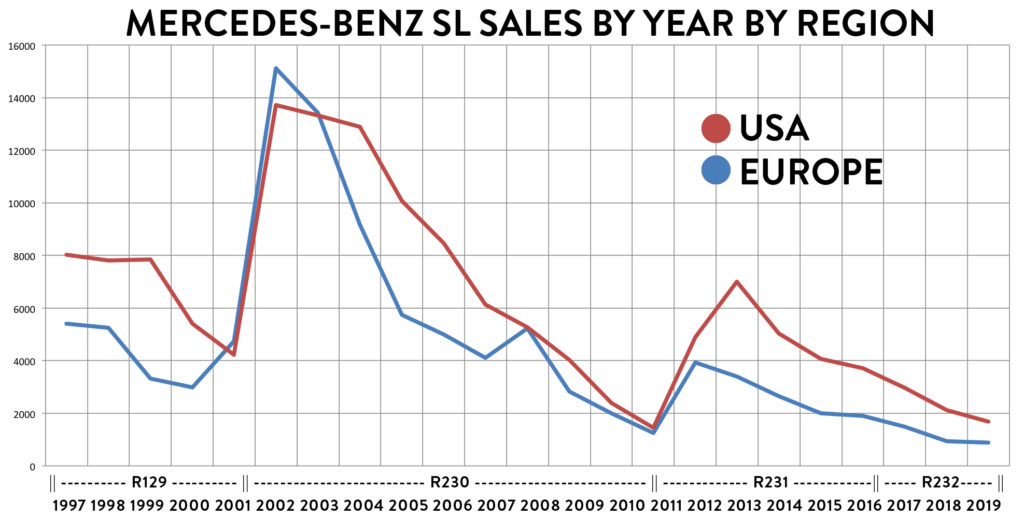
An analysis of the sales figures puts the data behind the conjecture.
Mercedes-Benz sold more than 15,000 SLs in 1984 (source), and other than a flurry of activity around the time the R230 arrived, hasn’t come close to those sales figures since. In 2019 less than 3,000 SLs were sold in the USA and Europe combined. Where are all the SL buyers, and what are they buying instead…? Gone are the days of the all-conquering R107.
Below: Aston Martin DB7, BMW 6 Series, Jaguar XK8, Lexus SC430, Porsche Boxster. All cars from manufacturers that (with the exception of the Jaguar E Type and XJS) weren’t stealing droves of SL customers in the 1970s and 80s.
What does a steady decline in SL sales mean for the value and appreciation of the classic SL?
Nostalgia is a wonderful thing, and it’s the fuel that the classic car industry runs on. The mantra of ‘they don’t make ‘em like they used to’ is absolutely true, and to park a 1989 SL and a 2019 SL side by side the differences are stark. You’ll go faster and use less fuel in the modern car, but where the new model wins the battle of mathematics it loses hands down on emotion. The feel, sounds and smell of the R107 are grounded in a golden time of automotive history; where build quality and status meant more than cold statistics. Sure, you can do 0-60 in substantially less time, but in a world of speed cameras and potholes, does it really matter?
The modern SL might have the technology to connect your phone to the car but does it have the capability to connect your soul to the road?
When it comes to a classic Mercedes-Benz SL, what you are buying is a slice of automotive history, a piece of the past where things seemed to matter, where wealth wasn’t calculated in monthly payments, where status wasn’t financed and where quality was paramount.
The R107 SL and the Pagoda before it were stalwarts of style, sophistication and status, a conscience choice for the self-made and the well heeled and a symbol of deliberate choice. The R129 and R230 that followed took the torch and ran with it, but the world was beginning to change.
-
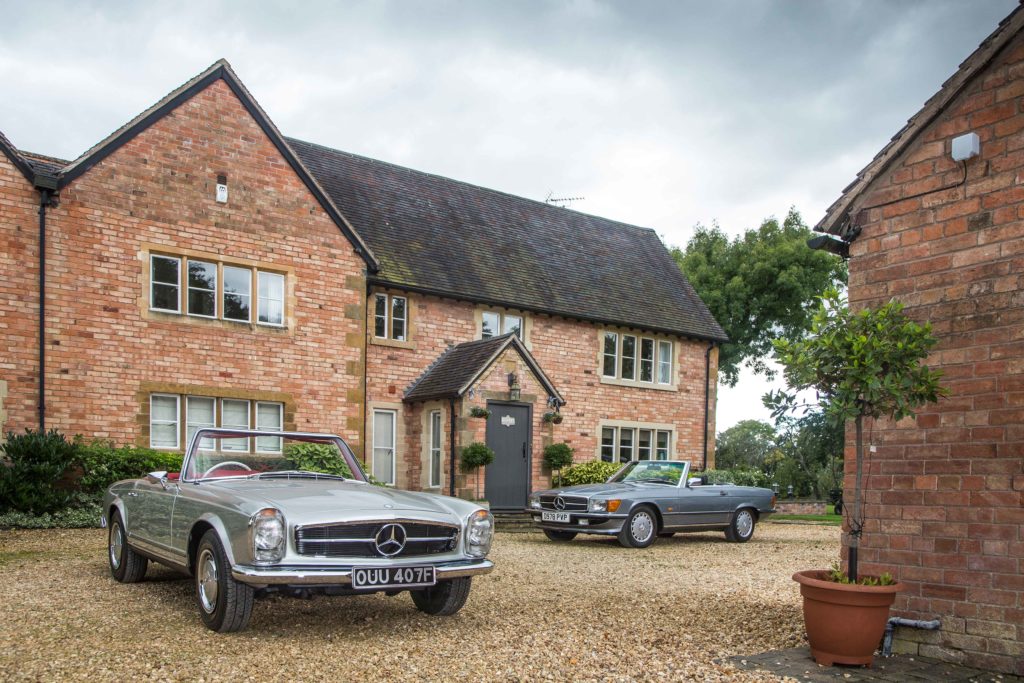
Stalwarts of style.
These cars offer an insight into a time that’s long gone, when values were different and life was simpler.
We love the modern SL and everything it stands for, but we’ll take the rose tinted specs and nostalgia every time. For us, it just feels right. And looks right. And smells right.
Whether it’s the lashings of chrome, the wood, the substantial weight of the controls or the way the car feels on the road, the R107 SL is a car that really has no equal. An expensive land yacht, an automotive artwork and an internationally appreciated shape that can still show modern traffic a thing or two when the right foot is applied liberally.
As the modern car landscape merges into a sea of confusion, too much choice, not enough variety and compromised design; the sturdy lines of the R107 and the way these cars continue to make us feel cements the relevance of these wonderful machines for now and years to come.
Thanks for reading – add your thoughts in the comments section!
We have a fantastic range of cars currently available in our showroom.
Curious as to what colours the R107 SL was offered in? We’ve got that covered here. Want to learn more about interior trim, to dream up your perfect SL? Look at our trim guide here.
The cars below are all taken from our current offering:
-
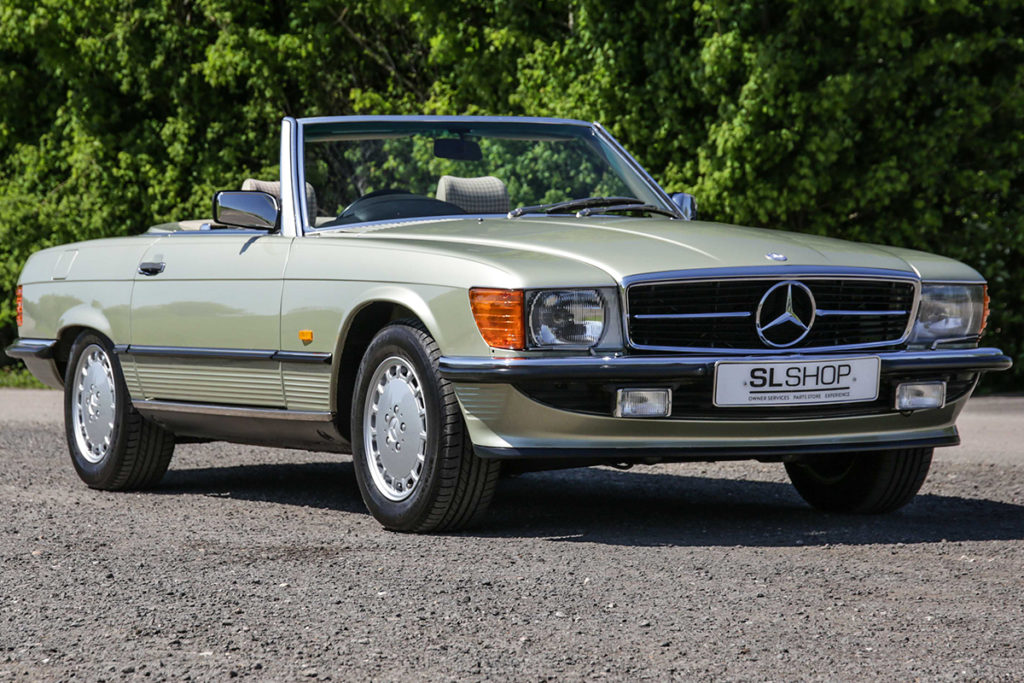
Thistle Green with Mushroom Check -
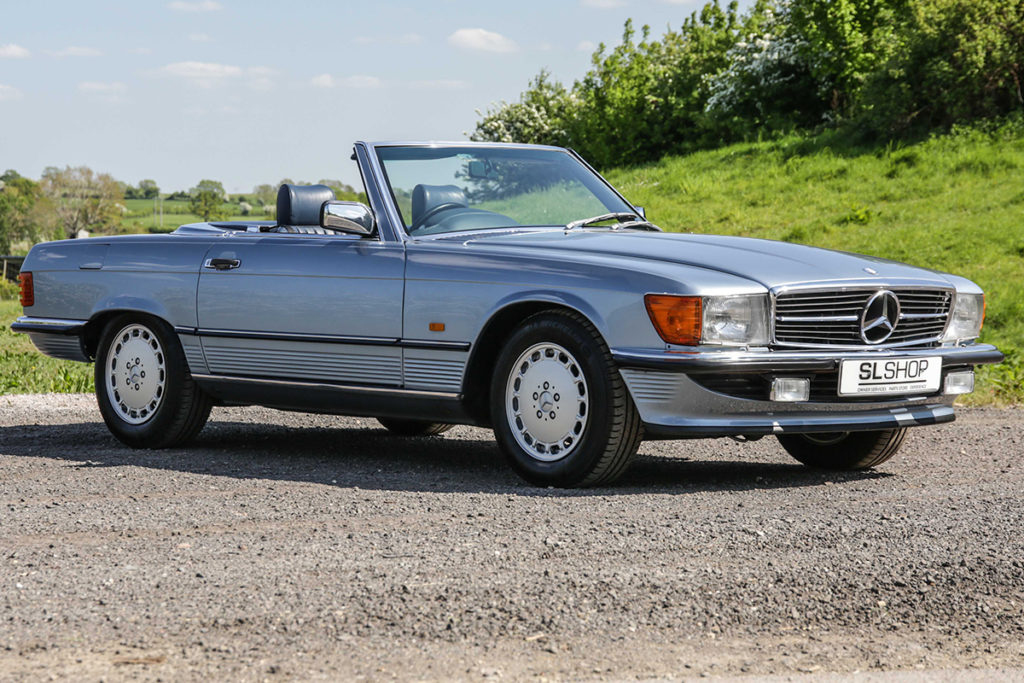
Diamond Blue with Blue -
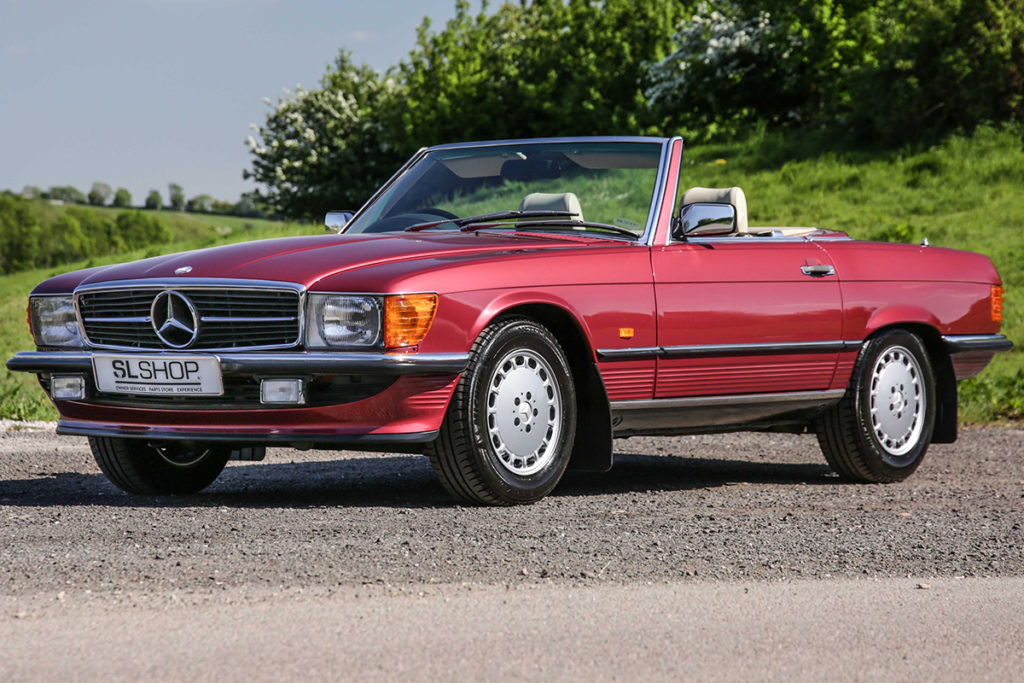
Pajett Red with Beige -
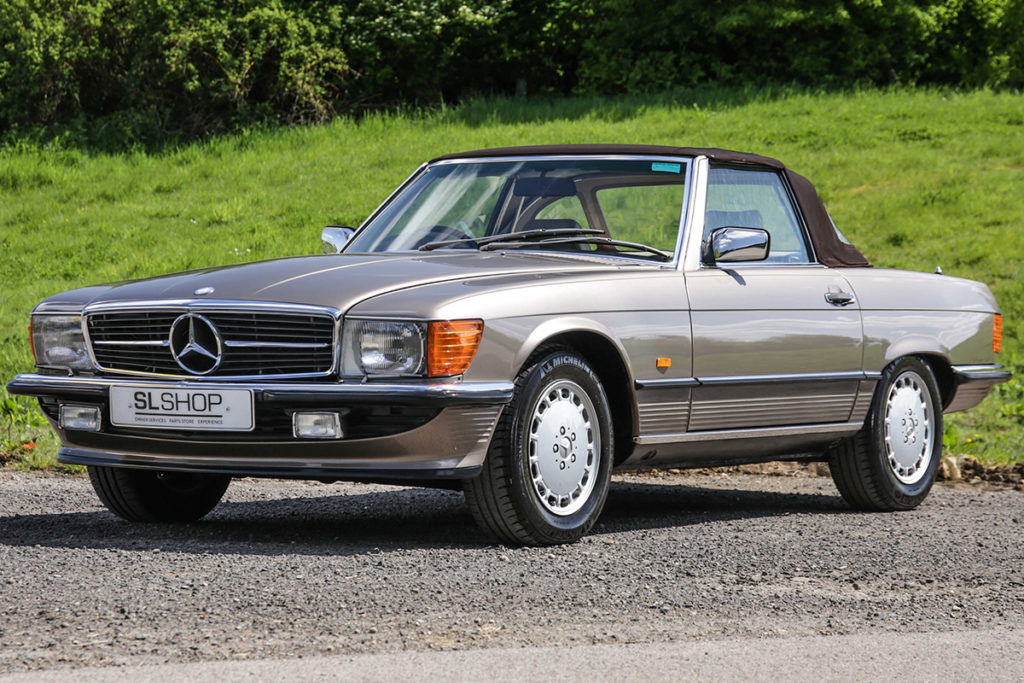
Impala Brown with Beige -
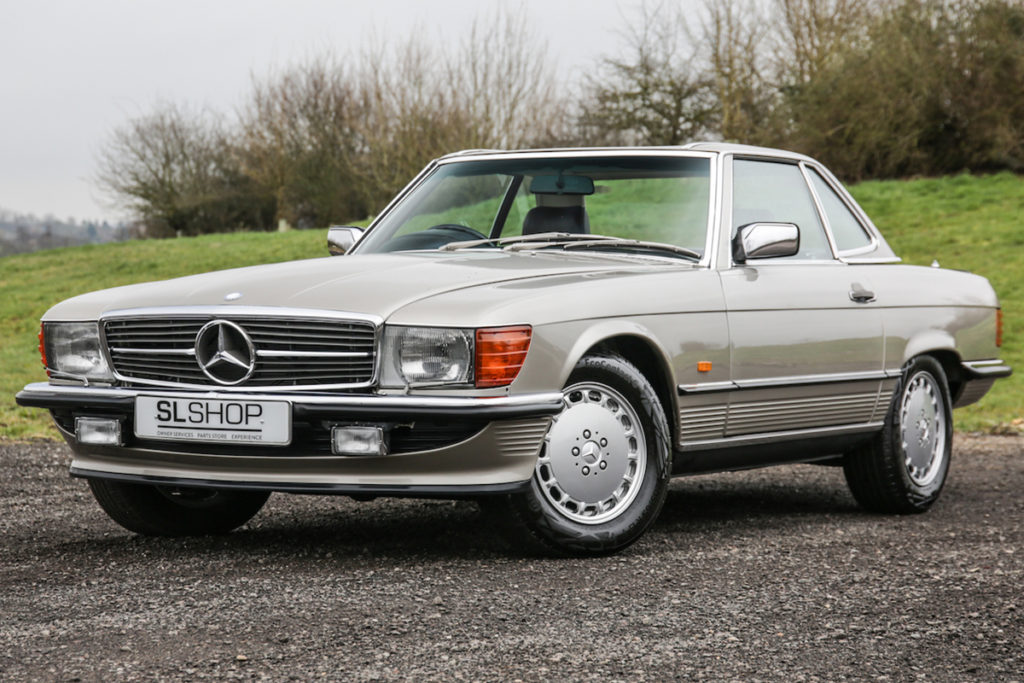
Smoke Silver with Red -
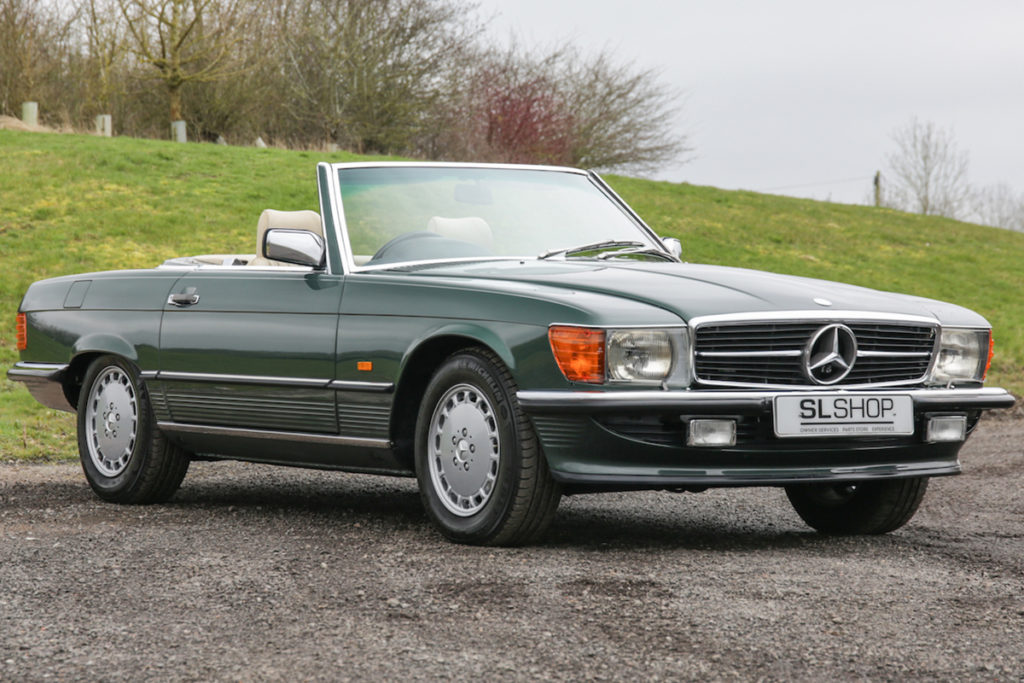
Pine Greeen with Mushroom
When the Mercedes-Benz R107 SL first arrived in 1971 it was an instant hit, a car so good that it would remain desirable, popular and relevant for a full 18 years.
The fact that the Mercedes-Benz R107 SL lived through two vibrant decades at the top of the market is an incredible achievement; and one that would never be repeated. The automotive landscape has changed greatly since the R107… things have changed.
So why in 2020, 30 years and 4 SL generations later (R129, R230, R231, R232) is the R107 still as relevant and desirable as ever?

A question of choice – the automotive market has changed
Back in 1989 Mercedes-Benz buyers had a choice of the 190E (small saloon) the 124 (bigger saloon, coupe or estate) the W126 (even bigger saloon, long wheel base saloon or big coupe) G Wagon (off roader) and the SL (luxurious convertible).
That’s a choice of just 8 models.
Mercedes-Benz Model Range 1989:
-

G Class -

W126 Saloon -

W126 Coupe -

W124 Coupe -

W124 Estate -

W124 Saloon -

W201 190E -

R107 SL
Fast forward 30 years and the automotive landscape is much more complex. In 2020 Mercedes-Benz buyers can have…
A hatchback (A Class), a bigger hatchback (B Class), a very small saloon (CLA), a small saloon (C Class), a bigger saloon (E Class), an even bigger saloon (S Class) a gigantic saloon (Maybach), a small estate (CLA), a medium estate (C Class), and a bigger estate (E Class)
Then it gets confusing…
A chunky looking hatchback off roader, (GLA), a small off roader that looks big (GLB), a small off roader (GLC), a more coupe looking small off roader (GLC Coupe), an electric off roader (EQC), a bigger off roader (GLE), a bigger but more coupe looking off roader (GLE Coupe), a full size off roader (GLS) or a utilitarian off roader (G Class).
None of which apart from the G Class are meant to go off road.
That’s before we look at the coupes and convertibles…
You can have a small coupe (CLA), medium sized coupe (C Class), bigger coupe (E Class) or an even bigger coupe (S Class), a four dour coupe (CLS), a very fast coupe (AMG GT) or a very fast four dour coupe (AMG GT-4).
The convertible range is thankfully a little easier to understand…
You can have a medium sized convertible with four seats (C Class), a bigger convertible with four seats (E Class), an even bigger convertible with four seats (S Class)… or a small convertible with two seats (SLC or what used to be the SLK), a bigger convertible with two seats (SL) or a very fast one with two seats (AMG GT).
Within all of those ranges you can have a cheap one that looks expensive, an economical one that looks fast, a slow one that looks fast, and a fast one that looks like a fast one. Or any combination of the above. Or a van. With or without seats and windows. Clear?
That’s a choice of more than 30 models!
Mercedes-Benz Model Range 2020:
Confused yet? You haven’t even started looking at the options list for interior equipment!
Back in 1989 prospective R107 SL buyers had a choice of 3 engines, with 14 different optional extras to choose from, as seen in our blog here.
In 2020 prospective SL buyers can choose from two trim levels, two engines, a multitude of equipment packs and a confusing plethora of optional extras.
A 2020 SL is available with 2 engines, 8 exterior or 3 interior colours.
A 1989 R107 SL was available with 3 engines, 10 flat colours, 14 metallic colours, and 8 variants of MB TEX, 8 variants of cloth and 8 variants of leather!
We might have laboured the point a little; but in 2020 we have more choice but it’s all at the expense of actually having choice. The modern options list gives plenty of choice over what your car can do, but less choice over what it looks like and how it feels.
When we advertise an R107 SL for sale and we say it’s a rare colour combination, we genuinely mean it. When we advertise an SL for sale and we say it’s a high specification car with many expensive options, we genuinely mean it.
The SL comes from a time in automotive history that was completely different to the world of motoring today.
There are certain colour and trim combinations for the R107 that we have never seen here at SLSHOP, despite the thousands of cars that have attended our workshops and showroom over the years. For us as enthusiasts and connoisseurs, that makes these rare old cars all the more appealing. The more unusual the colour and specification, the more special a car becomes. The cars shown below are good examples of this. Mid red leather is very rare to find, and we’ve only seen one Pine Green car to date.
(both of these cars can be found for sale in our showroom).
-

Pine Green… -

with Mushroom Leather -

Astral Silver… -

with Mid Red Leather
The Competition is finally competing
In a previous blog we’ve talked about the SL as a car without equal, a car that spent two decades without an obvious natural competitor. The R107 enjoyed a largely unchallenged reign in the luxury convertible sector – it was never intended to be a true sports car and it never pretended to be a true four-seater. As the SL developed and the R129 came to the fore, the competition from other manufacturers also increased. The R129 was facing a perfect storm of changing tastes and increased competition.
Jaguar’s XK8 arrived in the mid 1990s, BMW whipped the roof off the 6 Series in 2004 and contenders arrived from the likes of Lexus. In 1991 Ford took over Aston Martin, another company looking to steal market share from the all-conquering SL.
Not only was the SL facing competition from other luxury marques, but also the arrival of the Mazda MX5 changed the way we see open top cars forever. The decline of the British sports car played directly into the hands of the Mazda MX5, which arrived in 1989. The small sports car market was revived, a market that had floundered as the British motor industry declined. The success of the MX5 was followed by the MG F, BMW Z3 and then Mercedes-Benz’ own SLK, creating another sub-market for potential SL buyers looking for open top thrills. These small convertibles were now taking large bites out of R129 market share, competition from an area of the market that had only ever nibbled the heels of the R107.
People don’t pay like they used to
It’s impossible to discuss the changing automotive landscape without mentioning the meteoric rise of car finance. In the olden days, an expensive car was the sign wealth. The company car system was totally different to how it is today. As people progressed financially they were able to advance up the automotive ladder of life. One might progress from an L to a GL, with the dream of one day owning a GLE… As was perfectly explained by James May et al when talking about the Ford Cortina range during an episode of the Grand Tour.
The point here is that in the 1970s and early 80s, the Mercedes-Benz SL was so fantastically expensive it was virtually unobtainable for the vast majority of the general public. The fact that it was only within financial reach of the rich and famous made it an instant symbol of status. You had to be able to afford one to own one. That has all changed with the rise in car finance. People no longer need to save money to buy a flash car. For a down payment and a monthly fixed fee, buyers can get themselves behind the wheel of a car they’d never normally be able to afford to buy.
When we write descriptions of the SLs we offer for sale, we often calculate what the equivalent value would be in today’s money. These were £100,000 cars. Just imagine how it must have felt to drive an SL away from the showroom in the 1970s and 1980s, when a huge proportion of the nation were driving cars made by British Leyland. In that era, the SL must have felt like a car from a different world. It’s that slice of history that you are buying into when purchasing a classic SL. You are buying into an era where things seemed to matter just that bit more.
A changing world means changing tastes
In 2020 the luxury grand tourer segment is fragmented, with the SL even fighting off competition from what would traditionally have been called saloon cars. For the first time in it’s history the SL is facing an onslaught of competitors from a huge range of brands, and often not just competing against one particular model – a 2020 SL buyer might be tempted by a Porsche 911, Macan or Panamera in equal measure, not to mention the arrival of Tesla…!

An analysis of the sales figures puts the data behind the conjecture.
Mercedes-Benz sold more than 15,000 SLs in 1984 (source), and other than a flurry of activity around the time the R230 arrived, hasn’t come close to those sales figures since. In 2019 less than 3,000 SLs were sold in the USA and Europe combined. Where are all the SL buyers, and what are they buying instead…? Gone are the days of the all-conquering R107.
Below: Aston Martin DB7, BMW 6 Series, Jaguar XK8, Lexus SC430, Porsche Boxster. All cars from manufacturers that (with the exception of the Jaguar E Type and XJS) weren’t stealing droves of SL customers in the 1970s and 80s.
What does a steady decline in SL sales mean for the value and appreciation of the classic SL?
Nostalgia is a wonderful thing, and it’s the fuel that the classic car industry runs on. The mantra of ‘they don’t make ‘em like they used to’ is absolutely true, and to park a 1989 SL and a 2019 SL side by side the differences are stark. You’ll go faster and use less fuel in the modern car, but where the new model wins the battle of mathematics it loses hands down on emotion. The feel, sounds and smell of the R107 are grounded in a golden time of automotive history; where build quality and status meant more than cold statistics. Sure, you can do 0-60 in substantially less time, but in a world of speed cameras and potholes, does it really matter?
The modern SL might have the technology to connect your phone to the car but does it have the capability to connect your soul to the road?
When it comes to a classic Mercedes-Benz SL, what you are buying is a slice of automotive history, a piece of the past where things seemed to matter, where wealth wasn’t calculated in monthly payments, where status wasn’t financed and where quality was paramount.
The R107 SL and the Pagoda before it were stalwarts of style, sophistication and status, a conscience choice for the self-made and the well heeled and a symbol of deliberate choice. The R129 and R230 that followed took the torch and ran with it, but the world was beginning to change.
-

Stalwarts of style.
These cars offer an insight into a time that’s long gone, when values were different and life was simpler.
We love the modern SL and everything it stands for, but we’ll take the rose tinted specs and nostalgia every time. For us, it just feels right. And looks right. And smells right.
Whether it’s the lashings of chrome, the wood, the substantial weight of the controls or the way the car feels on the road, the R107 SL is a car that really has no equal. An expensive land yacht, an automotive artwork and an internationally appreciated shape that can still show modern traffic a thing or two when the right foot is applied liberally.
As the modern car landscape merges into a sea of confusion, too much choice, not enough variety and compromised design; the sturdy lines of the R107 and the way these cars continue to make us feel cements the relevance of these wonderful machines for now and years to come.
Thanks for reading – add your thoughts in the comments section!
We have a fantastic range of cars currently available in our showroom.
Curious as to what colours the R107 SL was offered in? We’ve got that covered here. Want to learn more about interior trim, to dream up your perfect SL? Look at our trim guide here.
The cars below are all taken from our current offering:
-

Thistle Green with Mushroom Check -

Diamond Blue with Blue -

Pajett Red with Beige -

Impala Brown with Beige -

Smoke Silver with Red -

Pine Greeen with Mushroom
More from Journal
CARE
THE ULTIMATE CERTIFIED SERVICING INVESTMENT PLAN
Your ownership journey matters to us, which is why we have created a simple certified servicing investment plan, tailored to your individual needs and aspirations.
Start investing today and our dedicated CARE team will work with you to increase the value and enjoyment you receive from your vehicle.

STAY IN TUNE WITH SLSHOP MOMENTS
As part of SLSHOP’s community of enthusiasts, you’ll be the first to hear about events and tours, key product offers, exciting stories from owners around the world and of course… our latest additions to the showroom. So, be the first to know and you might just sneak a car on your driveway or take your car’s condition to new heights with our exclusive replacement parts.
Or, visit SLSHOP Journal
